Paul van Yperen's Blog, page 415
June 25, 2014
Alfred Gerasch
Alfred Gerasch (1877-1954) was a popular Austrian stage actor who belonged to the exclusive circle of the ‘Königlich-Kaiserlichen Hofschauspielern’ (Royal Court Actors). He also acted in several silent and sound films, often playing historical figures.
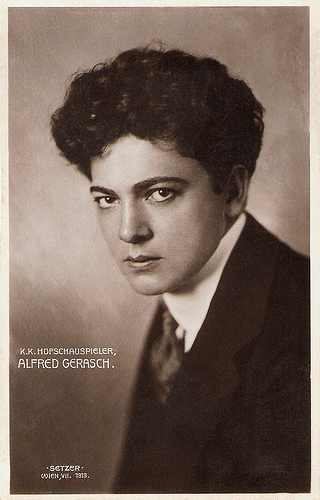
Austrian postcard by Postkartenverlag Brüder Kohn, Wien (Vienna). Photo: Setzer, Wien, 1913.
Royal Court Actor
Alfred Gerasch was born in Berlin in 1877. He made his stage debut at the Bellevue Theatre in Szczecin (now Poland). In 1897 he moved to Hamburg, and later to Oldenburg and to Karlsruhe. In 1907, he went to Vienna, where he was an ensemble member of the famous Burgtheater.
He became very popular among the Viennese theatre audiences as the young hero and lover in plays like Romeo and Juliet by William Shakespeare and Don Karlos by Friedrich Schiller.
Many great roles in the classic plays followed and the charismatic Gerasch was named ‘kaiserlich und königlichen Hofschauspieler’ (Royal Court Actor).
In 1919, the then 42-years old actor made his film debut in the role of the son of the main character in the Austrian production Adrian Vanderstraaten (Robert Land, 1919), followed by films like Durch die Quartiere des Elends und Verbrechens/Through the Neighborhoods of Misery and Crime (Robert Land, 1920) and Eine Million Dollar/One Million Dollar (Jacob Fleck, Luise Fleck 1921).
He returned to Berlin where he worked both for the stage and for the film industry. During the 1920s he appeared in such silent films as Die Legende von der heiligen Simplicia/The Legend of Holy Simplicity (Joe May, 1920) starring Eva May , Dagfin (Joe May, 1926) with Paul Richter , Eine Dubarry von heute/A Modern Dubarry (Alexander Korda, 1927) featuring María Corda , and Königin Luise, 2. Teil/Queen Luise, part 2 (Karl Grune, 1928) with Mady Christians .
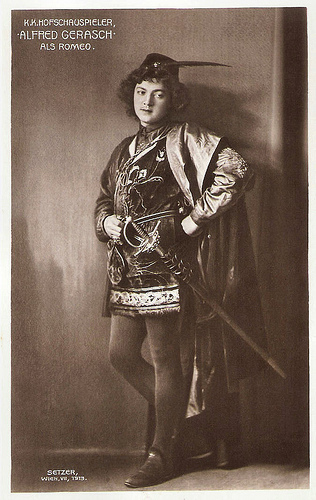
Austrian postcard by Postkartenverlag Brüder Kohn, Wien (Vienna). Photo: Setzer, Wien, 1913. Caption: "Alfred Gerasch als Romeo." (Alfred Gerasch as Romeo). Publicity still for a stage production of the play Romeo and Juliet by William Shakespeare.
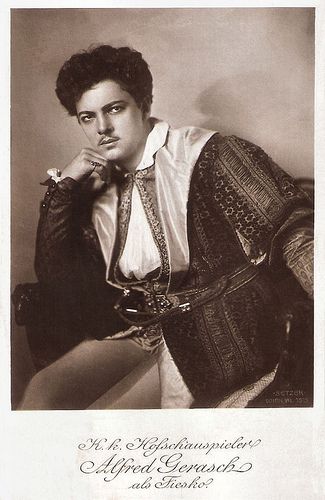
Austrian postcard by Postkartenverlag Brüder Kohn, Wien (Vienna), no. 887-1835. Photo: Setzer, Wien, 1913. Caption: K.k. Hofschauspieler Alfred Gerasch als Fiesko. Die Verschwörung des Fiesco zu Genua/Fiesco was the second full-length play by Friedrich Schiller. It is a republican tragedy based on the historical conspiracy of Giovanni Luigi Fieschi against Andrea Doria in Genoa in 1547. It premiered in Bonn in 1783 at the Hoftheater.
Historical Figures
After the introduction of sound film, Alfred Gerasch continued to play various supporting roles in films.
He often appeared as historical figures including Czar Alexander I in Napoleon auf St. Helena/Napoleon on St. Helena (Lupu Pick, 1929) with Werner Krauss , the Austrian-Hungarian chief of staff, Baron Franz Conrad von Hötzendorf in 1914, die letzten Tage vor dem Weltbrand/1914, The Last days Before the World Fire (Richard Oswald, 1931), the Austrian statesman Prince Metternich in Marschall vorwärts/Marshal Forward (Heinz Paul, 1932), Talleyrand - Napoleon’s Minister of Foreign Affairs in Hundert Tage/Hundred Days (Franz Wenzler, 1935), and Field Marshal General Daun in Fridericus (Johannes Meyer, 1937) starring Otto Gebühr .
From 1937 on, Gerasch lived in Vienna, Austria and his only film work from that period were a few guest appearances. He did appear in Zauber der Bohème/The Magic of Bohème (Géza von Bolváry, 1937), a film operetta tailor-made to the dream couple Jan Kiepura and Marta Eggerth . For this film he also served as co-author.
After 1945 he limited his work even more. His last film part was Roman emperor and philosopher Marcus Aurelius in the comedy Die Welt dreht sich verkehrt/The World Turns Upside Down (J.A. Hübler-Kahla, 1947) starring Hans Moser . He was 70 at the time.
Alfred Gerasch died in 1954 in Vienna.
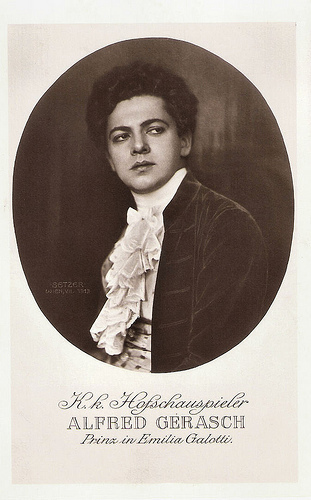
Austrian postcard by Postkartenverlag Brüder Kohn, Wien (Vienna). Photo: Setzer, Wien, 1913. Caption: "Prinz in Emilia Galotti." (Prince in Emilia Galotti). Emilia Galotti is a play in five acts by Gotthold Ephraim Lessing (1729–1781), which premiered on 8 March 1772 in Braunschweig (Brunswick). The work is a classic example of German 'bürgerliches Trauerspiel' (bourgeois tragedy). Lessing's work comprises an attack against the nobility and its powers. Lessing depicts aristocrats as having unfair powers in society and as ruining the happiness of the emerging middle class.
Sources: Stephanie D’heil (Steffi-line.de) (German), Thomas Staedeli (Cyranos), Wikipedia (German) and .

Austrian postcard by Postkartenverlag Brüder Kohn, Wien (Vienna). Photo: Setzer, Wien, 1913.
Royal Court Actor
Alfred Gerasch was born in Berlin in 1877. He made his stage debut at the Bellevue Theatre in Szczecin (now Poland). In 1897 he moved to Hamburg, and later to Oldenburg and to Karlsruhe. In 1907, he went to Vienna, where he was an ensemble member of the famous Burgtheater.
He became very popular among the Viennese theatre audiences as the young hero and lover in plays like Romeo and Juliet by William Shakespeare and Don Karlos by Friedrich Schiller.
Many great roles in the classic plays followed and the charismatic Gerasch was named ‘kaiserlich und königlichen Hofschauspieler’ (Royal Court Actor).
In 1919, the then 42-years old actor made his film debut in the role of the son of the main character in the Austrian production Adrian Vanderstraaten (Robert Land, 1919), followed by films like Durch die Quartiere des Elends und Verbrechens/Through the Neighborhoods of Misery and Crime (Robert Land, 1920) and Eine Million Dollar/One Million Dollar (Jacob Fleck, Luise Fleck 1921).
He returned to Berlin where he worked both for the stage and for the film industry. During the 1920s he appeared in such silent films as Die Legende von der heiligen Simplicia/The Legend of Holy Simplicity (Joe May, 1920) starring Eva May , Dagfin (Joe May, 1926) with Paul Richter , Eine Dubarry von heute/A Modern Dubarry (Alexander Korda, 1927) featuring María Corda , and Königin Luise, 2. Teil/Queen Luise, part 2 (Karl Grune, 1928) with Mady Christians .

Austrian postcard by Postkartenverlag Brüder Kohn, Wien (Vienna). Photo: Setzer, Wien, 1913. Caption: "Alfred Gerasch als Romeo." (Alfred Gerasch as Romeo). Publicity still for a stage production of the play Romeo and Juliet by William Shakespeare.

Austrian postcard by Postkartenverlag Brüder Kohn, Wien (Vienna), no. 887-1835. Photo: Setzer, Wien, 1913. Caption: K.k. Hofschauspieler Alfred Gerasch als Fiesko. Die Verschwörung des Fiesco zu Genua/Fiesco was the second full-length play by Friedrich Schiller. It is a republican tragedy based on the historical conspiracy of Giovanni Luigi Fieschi against Andrea Doria in Genoa in 1547. It premiered in Bonn in 1783 at the Hoftheater.
Historical Figures
After the introduction of sound film, Alfred Gerasch continued to play various supporting roles in films.
He often appeared as historical figures including Czar Alexander I in Napoleon auf St. Helena/Napoleon on St. Helena (Lupu Pick, 1929) with Werner Krauss , the Austrian-Hungarian chief of staff, Baron Franz Conrad von Hötzendorf in 1914, die letzten Tage vor dem Weltbrand/1914, The Last days Before the World Fire (Richard Oswald, 1931), the Austrian statesman Prince Metternich in Marschall vorwärts/Marshal Forward (Heinz Paul, 1932), Talleyrand - Napoleon’s Minister of Foreign Affairs in Hundert Tage/Hundred Days (Franz Wenzler, 1935), and Field Marshal General Daun in Fridericus (Johannes Meyer, 1937) starring Otto Gebühr .
From 1937 on, Gerasch lived in Vienna, Austria and his only film work from that period were a few guest appearances. He did appear in Zauber der Bohème/The Magic of Bohème (Géza von Bolváry, 1937), a film operetta tailor-made to the dream couple Jan Kiepura and Marta Eggerth . For this film he also served as co-author.
After 1945 he limited his work even more. His last film part was Roman emperor and philosopher Marcus Aurelius in the comedy Die Welt dreht sich verkehrt/The World Turns Upside Down (J.A. Hübler-Kahla, 1947) starring Hans Moser . He was 70 at the time.
Alfred Gerasch died in 1954 in Vienna.

Austrian postcard by Postkartenverlag Brüder Kohn, Wien (Vienna). Photo: Setzer, Wien, 1913. Caption: "Prinz in Emilia Galotti." (Prince in Emilia Galotti). Emilia Galotti is a play in five acts by Gotthold Ephraim Lessing (1729–1781), which premiered on 8 March 1772 in Braunschweig (Brunswick). The work is a classic example of German 'bürgerliches Trauerspiel' (bourgeois tragedy). Lessing's work comprises an attack against the nobility and its powers. Lessing depicts aristocrats as having unfair powers in society and as ruining the happiness of the emerging middle class.
Sources: Stephanie D’heil (Steffi-line.de) (German), Thomas Staedeli (Cyranos), Wikipedia (German) and .
Published on June 25, 2014 23:00
June 24, 2014
Jean Rochefort
Jean Rochefort (1930) is a French actor, with a career that has spanned over five decades. He is best known for the comedies Le Grand Blond avec Une Chasseure Noire/The Tall Blond Man with One Black Shoe (1972), Nous irons tous au paradis/We Will All Meet in Paradise (1977) and Le Mari de la coiffeuse/The Hairdresser's Husband (1990).
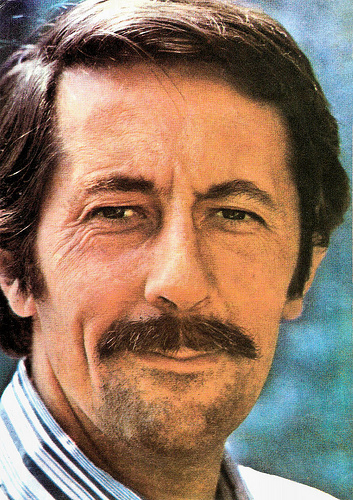
Romanian postcard by Casa Filmului Acin, no. 569.
Passion for horses
Jean Rochefort was born in Paris, France in 1930.
He was educated at the Lycée Pierre Corneille in Rouen. At 19, he entered the Centre d'Art Dramatique de la rue Blanche. Later he joined the Conservatoire National.
After his national service, in 1953, he worked with the Compagnie Grenier Hussenot as a theatre actor for seven years. There he was noticed for his ability to play both drama and comedy. He also worked as director.
In 1956, he made his film debut in the sentimental comedy Rencontre à Paris/Meeting in Paris (Georges Lampin, 1956). He decided to become a television and cinema actor.
Rochefort played supporting roles in the adventure films Le Capitaine Fracasse/Captain Fracasse (Pierre Gaspard-Huit, 1961) with Jean Marais , Cartouche/Swords of Blood (Philippe de Broca, 1962) starring Jean-Paul Belmondo , and Merveilleuse Angélique/Angelique: The Road to Versailles (Bernard Borderie, 1965) featuring Michèle Mercier .
During the shooting of Cartouche, he discovered his passion for horses and equestrianism. He has been a horse breeder since then and now owns Le Haras de Villequoy. His passion led him to become a horse consultant for French television in 2004.
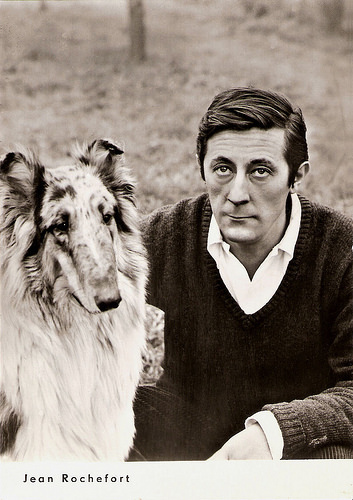
East-German postcard by VEB Progress Film-Vertrieb, Berlin, no. 23/71, 1971. Photo: Unifrance-Film.
Midlife Crisis Comedy
Jean Rochefort played his first big role in Les Feux de la Chandeleur/Hearth Fires (Serge Korber, 1972) with Annie Girardot as his wife and Claude Jade as their daughter. In this drama he starred as a man who leaves his family for ten years and then returns.
That year, he also starred opposite Pierre Richard as Chief of Counter-Espionage Louis Toulouse in the comedy Le Grand Blond avec Une Chasseure Noire/The Tall Blond Man with One Black Shoe (Yves Robert, 1972). The box office hit was remade in English as The Man with One Red Shoe (Stan Dragoti, 1985) with Tom Hanks and Dabney Coleman in the role of Rochefort.
He reprised this role in the sequel Le Retour du Grand Blond/The Return of the Tall Blond Man with One Black Shoe (Yves Robert, 1974).
In between he appeared in interesting films like L'Horloger de Saint-Paul/The Clockmaker (Bertrand Tavernier, 1974) and Le fantôme de la liberté/The Phantom of Liberty (Luis Buñuel, 1974).
He was the leading star of the midlife crisis comedy Un éléphant ça trompe énormément An Elephant Can Be Extremely Deceptive (Yves Robert, 1976) as a man who risks his married life with Danièle Delorme for an affair with Anny Duperey.
Thanks to this comedy, Rochefort got a big popularity and he starred also in the sequel, Nous irons tous au paradis/We Will All Meet in Paradise (Yves Robert, 1977).
The next step were such international films as French Postcards (Willard Huyck, 1979).
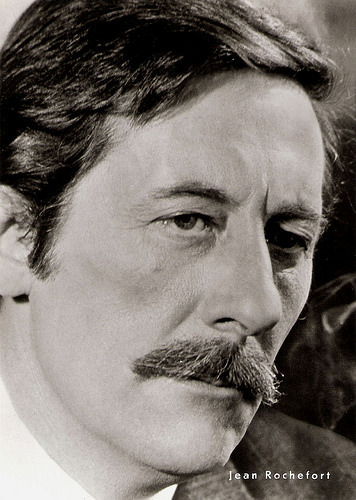
East-German postcard by VEB Progress Filmvertrieb, Berlin, no. 12/78, 1978. Retail price: 0,20 DM.
The Hairdresser's Husband
During the 1980s, Jean Rochefort appeared in less prominent films.
An international success was the comedy Le Mari de la coiffeuse/The Hairdresser's Husband (Patrice Laconte, 1990), co-starring Anna Galiena.
Also remarkable was the satirical comedy Prêt-à-Porter/Ready to Wear (Robert Altman, 1994), shot during the Paris Fashion Week with a host of international stars, models and designers.
Another success was the historical film Ridicule (Patrice Leconte, 1996) examines the social injustices of late 18th century France, in showing the corruption and callousness of the aristocrats.
In 1998, he starred as Fernand de Morcerf opposite Gérard Depardieu in the mini-series Le Comte de Monte Cristo/The Count of Monte Christo (Josée Dayan, 1998). He has won two César Awards: in 1976, Best Supporting Actor for Que la fête commence/Let Joy Reign Supreme (Bertrand Tavernier, 1975); and in 1978, Best Actor for his role as a dying French naval frigate captain in Le Crabe-tambour/Drummer-Crab (Pierre Schoendoerffer, 1977).
In 1960 he married Alexandra Moscwa, with whom he fathered two children: a girl, Marie (1962), and a boy, Julien (1965). They later divorced and in all he has five children: Marie, Julien, Pierre, Clémence and Louise.
Recent films with Rochefort are Mr. Bean's Holiday (Steve Bendelack, 2007) featuring Rowan Atkinson , L'artiste et son modèle/The Artist and the Model (Fernando Trueba, 2012) and Astérix & Obélix: Au service de Sa Majesté/Asterix and Obelix: God Save Britannia (Laurent Tirard, 2012).
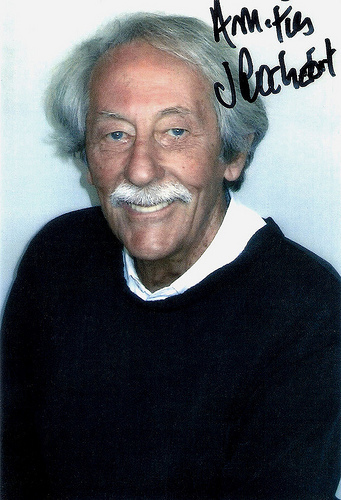
Original photo.
Sources: Wikipedia, and .

Romanian postcard by Casa Filmului Acin, no. 569.
Passion for horses
Jean Rochefort was born in Paris, France in 1930.
He was educated at the Lycée Pierre Corneille in Rouen. At 19, he entered the Centre d'Art Dramatique de la rue Blanche. Later he joined the Conservatoire National.
After his national service, in 1953, he worked with the Compagnie Grenier Hussenot as a theatre actor for seven years. There he was noticed for his ability to play both drama and comedy. He also worked as director.
In 1956, he made his film debut in the sentimental comedy Rencontre à Paris/Meeting in Paris (Georges Lampin, 1956). He decided to become a television and cinema actor.
Rochefort played supporting roles in the adventure films Le Capitaine Fracasse/Captain Fracasse (Pierre Gaspard-Huit, 1961) with Jean Marais , Cartouche/Swords of Blood (Philippe de Broca, 1962) starring Jean-Paul Belmondo , and Merveilleuse Angélique/Angelique: The Road to Versailles (Bernard Borderie, 1965) featuring Michèle Mercier .
During the shooting of Cartouche, he discovered his passion for horses and equestrianism. He has been a horse breeder since then and now owns Le Haras de Villequoy. His passion led him to become a horse consultant for French television in 2004.

East-German postcard by VEB Progress Film-Vertrieb, Berlin, no. 23/71, 1971. Photo: Unifrance-Film.
Midlife Crisis Comedy
Jean Rochefort played his first big role in Les Feux de la Chandeleur/Hearth Fires (Serge Korber, 1972) with Annie Girardot as his wife and Claude Jade as their daughter. In this drama he starred as a man who leaves his family for ten years and then returns.
That year, he also starred opposite Pierre Richard as Chief of Counter-Espionage Louis Toulouse in the comedy Le Grand Blond avec Une Chasseure Noire/The Tall Blond Man with One Black Shoe (Yves Robert, 1972). The box office hit was remade in English as The Man with One Red Shoe (Stan Dragoti, 1985) with Tom Hanks and Dabney Coleman in the role of Rochefort.
He reprised this role in the sequel Le Retour du Grand Blond/The Return of the Tall Blond Man with One Black Shoe (Yves Robert, 1974).
In between he appeared in interesting films like L'Horloger de Saint-Paul/The Clockmaker (Bertrand Tavernier, 1974) and Le fantôme de la liberté/The Phantom of Liberty (Luis Buñuel, 1974).
He was the leading star of the midlife crisis comedy Un éléphant ça trompe énormément An Elephant Can Be Extremely Deceptive (Yves Robert, 1976) as a man who risks his married life with Danièle Delorme for an affair with Anny Duperey.
Thanks to this comedy, Rochefort got a big popularity and he starred also in the sequel, Nous irons tous au paradis/We Will All Meet in Paradise (Yves Robert, 1977).
The next step were such international films as French Postcards (Willard Huyck, 1979).

East-German postcard by VEB Progress Filmvertrieb, Berlin, no. 12/78, 1978. Retail price: 0,20 DM.
The Hairdresser's Husband
During the 1980s, Jean Rochefort appeared in less prominent films.
An international success was the comedy Le Mari de la coiffeuse/The Hairdresser's Husband (Patrice Laconte, 1990), co-starring Anna Galiena.
Also remarkable was the satirical comedy Prêt-à-Porter/Ready to Wear (Robert Altman, 1994), shot during the Paris Fashion Week with a host of international stars, models and designers.
Another success was the historical film Ridicule (Patrice Leconte, 1996) examines the social injustices of late 18th century France, in showing the corruption and callousness of the aristocrats.
In 1998, he starred as Fernand de Morcerf opposite Gérard Depardieu in the mini-series Le Comte de Monte Cristo/The Count of Monte Christo (Josée Dayan, 1998). He has won two César Awards: in 1976, Best Supporting Actor for Que la fête commence/Let Joy Reign Supreme (Bertrand Tavernier, 1975); and in 1978, Best Actor for his role as a dying French naval frigate captain in Le Crabe-tambour/Drummer-Crab (Pierre Schoendoerffer, 1977).
In 1960 he married Alexandra Moscwa, with whom he fathered two children: a girl, Marie (1962), and a boy, Julien (1965). They later divorced and in all he has five children: Marie, Julien, Pierre, Clémence and Louise.
Recent films with Rochefort are Mr. Bean's Holiday (Steve Bendelack, 2007) featuring Rowan Atkinson , L'artiste et son modèle/The Artist and the Model (Fernando Trueba, 2012) and Astérix & Obélix: Au service de Sa Majesté/Asterix and Obelix: God Save Britannia (Laurent Tirard, 2012).

Original photo.
Sources: Wikipedia, and .
Published on June 24, 2014 23:00
June 23, 2014
May Britt
Blonde, blue-eyed Swedish actress May Britt (1933) had a brief career as a film star in the 1950’s, first in Italy and later in the United States. She retired from the screen after she married Sammy Davis, Jr. in 1960.
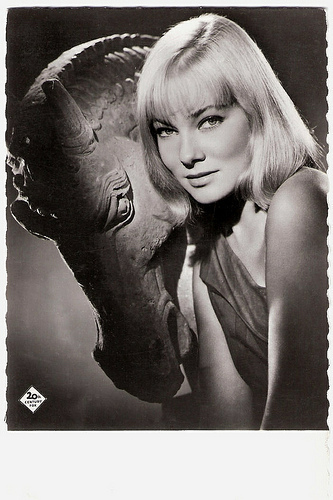
French postcard by Editions P.I., no. 943. Photo: 20th Century Fox.
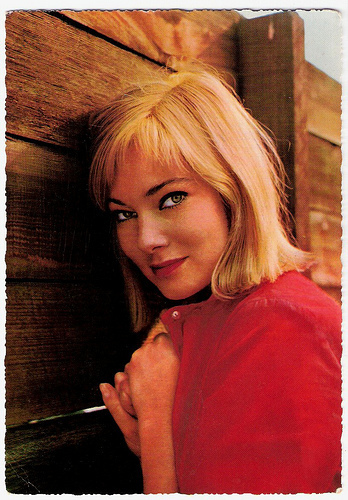
German postcard by Krüger, no. 902/62.
Cinecittà
Maybritt Wilkens was born in 1933 (some sources mention 1934), in the Stockholm suburb of Lidingö, Sweden. Her father, Hugo Brigg-Wilkens, was a postal inspector; her mother was a housewife.
Maybritt was only 18 and working as a photographer's assistant, when she was discovered by two Italian film-makers. Producer Carlo Ponti and director Mario Soldati were in Sweden to cast a young blonde woman for the title role in a new film.
They came to the studio where she worked to view photographs of models. After meeting her, they offered her the part instead. May Britt, as she was renamed professionally, immediately moved to Rome.
She made her film debut as the leading actress in the adventure film Jolanda la figlia del corsaro nero/Jolanda, the Daughter of the Black Corsair (Mario Soldati, 1952) with Renato Salvatori .
In the following years she worked in a dozen Cinecittà productions, including the 3-D opera adaptation Cavalleria rusticana/Fatal Desire (Carmine Gallone, 1953) with Anthony Quinn, Le infedeli/Unfaithful (Mario Monicelli, Steno, 1953) with Gina Lollobrigida , and La lupa/The She-Wolf (Alberto Lattuada, 1953).
She also featured in international productions like the Eddie Constantine vehicle Ça va barder/Give 'em Hell (John Berry, 1955) and the epic Leo Tolstoy adaptation War and Peace (King Vidor, 1956) starring Audrey Hepburn , Mel Ferrer and Henry Fonda.
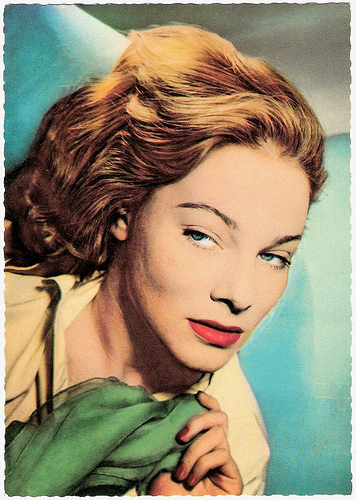
German postcard by ISV, no. D 1. Photo: Luxardo.
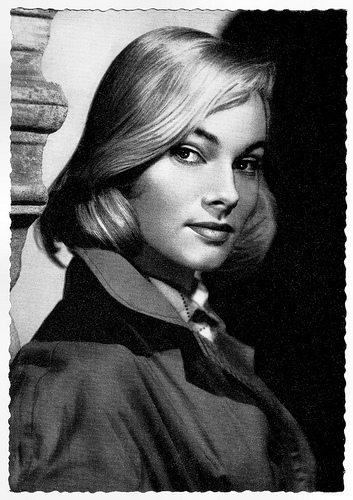
German postcard by Filmbilder-Vertrieb Ernst Freihoff, Essen, no. 115. Retail price: 25 Pfg. Photo: Dial / Unitalia Film.
Lola-Lola
In 1957, May Britt relocated to Hollywood after signing with 20th Century Fox. She starred in a few films, including the World War 2 drama The Young Lions (Edward Dmytryk, 1958) with Marlon Brando and the crime drama Murder, Inc. (Burt Balaban, Stuart Rosenberg, 1960) with Peter Falk.
She also played the lead role in the remake of The Blue Angel (1959, Edward Dmytryk) co-starring Curd Jürgens .
May Britt was first bombarded with adverse criticism for having the ‘audacity’ to step into the foortsteps of Marlene Dietrich but her performance as Lola-Lola got pretty good reviews. A reviewer at IMDb even writes: “well made production with fine performances from Jurgens and May Britt, who shines as showgirl Lola Lola. Ms. Britt did a wonderful job recreating the old Dietrich role and in my opinion was much better.”
In 1959, after a brief marriage to Edwin Gregson (1958-1959), the 19-year old son of a Southern California real estate millionaire, she met Sammy Davis, Jr., the famous black entertainer. They began dating, and, after a brief engagement, were married in 1960.
As one of the first interracial couples in Hollywood, Sammy and May were the target of nasty jokes, vicious slurs and death threats, but both survived the ordeal thanks to the strong and protective support of industry friends.
20th Century-Fox didn't renew her contract though. The studio refused to say if the action was a result of her plans to marry Davis.
A rumor or myth, John F. Kennedy and Robert F. Kennedy told Frank Sinatra to tell Sammy not to marry May until after the 1960 Presidential Election. At that time interracial marriage was forbidden by law in 31 U.S. states, and only in 1967 were those laws abolished by the U.S. Supreme Court.
Prior to the wedding, Britt converted to Judaism. She and Davis had one daughter and adopted two sons, and May retired to take care of her children. They divorced in 1968 after Davis reportedly had an affair with dancer Lola Falana.
In 1967 May Britt resumed working and did television guest appearances in TV series like Mission: Impossible (1969).
May Britt made a long overdue comeback to the screen in the quirky little thriller Haunts (Herb Freed, 1977). Reviewer Cavett Binion of AllMovie calls it “a surprisingly original murder mystery with some well-executed twists” and “This seedy but fun horror film is buoyed by Britt's enjoyably loony performance”.
Her last appearance was in the Sci-Fi TV series Probe (1988).
May Britt retired and since then she has mainly been involved in painting. In 1993 May Britt married Lennart Ringquist. They live in Los Angeles, California.
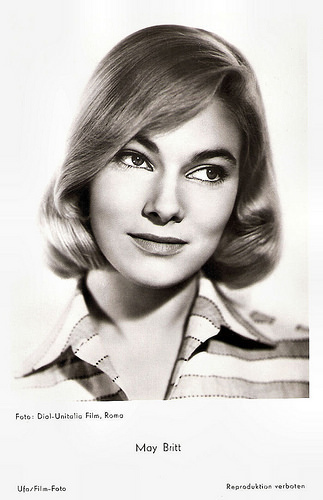
German postcard by Ufa, Berlin-Tempelhof, no. FK 2249. Photo: Dial / Unitalia Film.
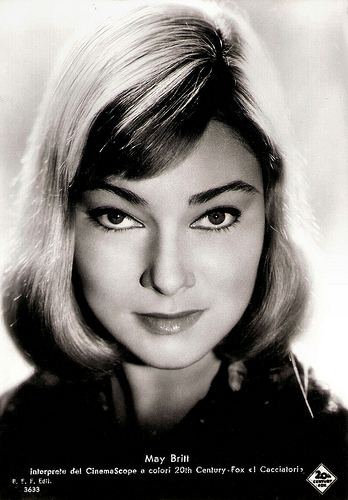
Italian postcard by B.F.F. Edit., no. 3633. Photo: 20th Century Fox. Publicity still for The Hunters (Dick Powell, 1958).
Sources: Hal Erickson (AllMovie), (IMDb), Cavett Binion (AllMovie), Glamour Girls of the Silver Screen, Wikipedia and .

French postcard by Editions P.I., no. 943. Photo: 20th Century Fox.

German postcard by Krüger, no. 902/62.
Cinecittà
Maybritt Wilkens was born in 1933 (some sources mention 1934), in the Stockholm suburb of Lidingö, Sweden. Her father, Hugo Brigg-Wilkens, was a postal inspector; her mother was a housewife.
Maybritt was only 18 and working as a photographer's assistant, when she was discovered by two Italian film-makers. Producer Carlo Ponti and director Mario Soldati were in Sweden to cast a young blonde woman for the title role in a new film.
They came to the studio where she worked to view photographs of models. After meeting her, they offered her the part instead. May Britt, as she was renamed professionally, immediately moved to Rome.
She made her film debut as the leading actress in the adventure film Jolanda la figlia del corsaro nero/Jolanda, the Daughter of the Black Corsair (Mario Soldati, 1952) with Renato Salvatori .
In the following years she worked in a dozen Cinecittà productions, including the 3-D opera adaptation Cavalleria rusticana/Fatal Desire (Carmine Gallone, 1953) with Anthony Quinn, Le infedeli/Unfaithful (Mario Monicelli, Steno, 1953) with Gina Lollobrigida , and La lupa/The She-Wolf (Alberto Lattuada, 1953).
She also featured in international productions like the Eddie Constantine vehicle Ça va barder/Give 'em Hell (John Berry, 1955) and the epic Leo Tolstoy adaptation War and Peace (King Vidor, 1956) starring Audrey Hepburn , Mel Ferrer and Henry Fonda.

German postcard by ISV, no. D 1. Photo: Luxardo.

German postcard by Filmbilder-Vertrieb Ernst Freihoff, Essen, no. 115. Retail price: 25 Pfg. Photo: Dial / Unitalia Film.
Lola-Lola
In 1957, May Britt relocated to Hollywood after signing with 20th Century Fox. She starred in a few films, including the World War 2 drama The Young Lions (Edward Dmytryk, 1958) with Marlon Brando and the crime drama Murder, Inc. (Burt Balaban, Stuart Rosenberg, 1960) with Peter Falk.
She also played the lead role in the remake of The Blue Angel (1959, Edward Dmytryk) co-starring Curd Jürgens .
May Britt was first bombarded with adverse criticism for having the ‘audacity’ to step into the foortsteps of Marlene Dietrich but her performance as Lola-Lola got pretty good reviews. A reviewer at IMDb even writes: “well made production with fine performances from Jurgens and May Britt, who shines as showgirl Lola Lola. Ms. Britt did a wonderful job recreating the old Dietrich role and in my opinion was much better.”
In 1959, after a brief marriage to Edwin Gregson (1958-1959), the 19-year old son of a Southern California real estate millionaire, she met Sammy Davis, Jr., the famous black entertainer. They began dating, and, after a brief engagement, were married in 1960.
As one of the first interracial couples in Hollywood, Sammy and May were the target of nasty jokes, vicious slurs and death threats, but both survived the ordeal thanks to the strong and protective support of industry friends.
20th Century-Fox didn't renew her contract though. The studio refused to say if the action was a result of her plans to marry Davis.
A rumor or myth, John F. Kennedy and Robert F. Kennedy told Frank Sinatra to tell Sammy not to marry May until after the 1960 Presidential Election. At that time interracial marriage was forbidden by law in 31 U.S. states, and only in 1967 were those laws abolished by the U.S. Supreme Court.
Prior to the wedding, Britt converted to Judaism. She and Davis had one daughter and adopted two sons, and May retired to take care of her children. They divorced in 1968 after Davis reportedly had an affair with dancer Lola Falana.
In 1967 May Britt resumed working and did television guest appearances in TV series like Mission: Impossible (1969).
May Britt made a long overdue comeback to the screen in the quirky little thriller Haunts (Herb Freed, 1977). Reviewer Cavett Binion of AllMovie calls it “a surprisingly original murder mystery with some well-executed twists” and “This seedy but fun horror film is buoyed by Britt's enjoyably loony performance”.
Her last appearance was in the Sci-Fi TV series Probe (1988).
May Britt retired and since then she has mainly been involved in painting. In 1993 May Britt married Lennart Ringquist. They live in Los Angeles, California.

German postcard by Ufa, Berlin-Tempelhof, no. FK 2249. Photo: Dial / Unitalia Film.

Italian postcard by B.F.F. Edit., no. 3633. Photo: 20th Century Fox. Publicity still for The Hunters (Dick Powell, 1958).
Sources: Hal Erickson (AllMovie), (IMDb), Cavett Binion (AllMovie), Glamour Girls of the Silver Screen, Wikipedia and .
Published on June 23, 2014 23:00
June 22, 2014
Florent Pagny
French musician Florent Pagny (1961) acted in many French films. He records songs in French, Italian, Spanish and English, and his best known songs include the #1 hits N'importe quoi, Savoir aimer and Ma Liberté de penser.
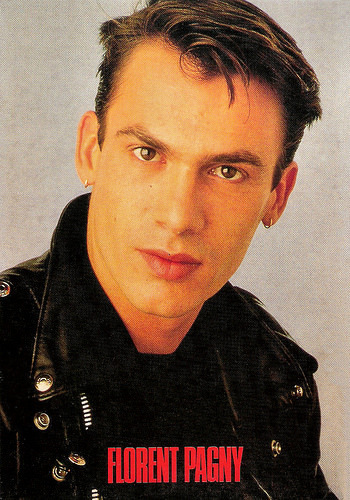
French postcard, no. 1152.
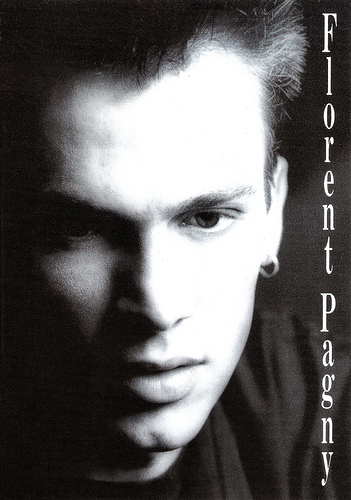
French postcard, no. C 101.
Controversy and boycot
Florent Pagny was born in Chalon-sur-Saône, France in 1961.
Pagny began his career as an extra in such films as the comedy Les surdoués de la première compagnie/The gifted of the first company (Michel Gérard, 1981), and the romance L'amour nu/The naked love (Yannick Bellon, 1981) with Marlène Jobert .
On TV he appeared in the drama series Les maupas (Jean-François Toussaint, 1982) with Yves Rénier, and Marion (Jean Pignol, 1982) featuring Mylène Demongeot .
He played a boxer in the adventure comedy L'as des as (Gérard Oury, 1982) starring Jean-Paul Belmondo .
He also played supporting roles in other popular films like La Balance (Bob Swaim, 1982) with Nathalie Baye, and the historical war drama Fort Saganne (Alain Corneau, 1984) with Gérard Depardieu and Catherine Deneuve .
Pagny had his first lead role in the musical drama Blessure (Michel Gérard, 1985). Interesting is also the Romanian film François Villon - Poetul vagabond/François Villon: The Maverick Poet (Sergiu Nicolaescu, 1987), in which Pagny played the title character.
In 1987, he wrote his first song N'importe quoi. He was discovered by artistic agent Dominique Besnehard, who gave him a record contract.
He continued working as an actor, such as in La fille des collines/The girl from the hills (Robin Davis, 1990).
Pagny's first album, Merci, was released in 1990. The album's songs, mainly written by himself, began to attract controversy, with the press eventually boycotting some of them. This led to a decline in sales, culminating in personal problems.
His follow-up album, Réaliste, was also not successful. He also made headlines because his love affair with singer-actress Vanessa Paradis .
Jean-Jacques Goldman wrote three songs for Pagny under the pseudonym Sam Brewski, and presented to him a new staff.
The album Rester vrai marked the beginning of his career as a performer only. Bienvenue chez moi, a semi-compilation released in 1995, was a smash success. Pagny also covered Caruso, the hit originally performed by Lucio Dalla.
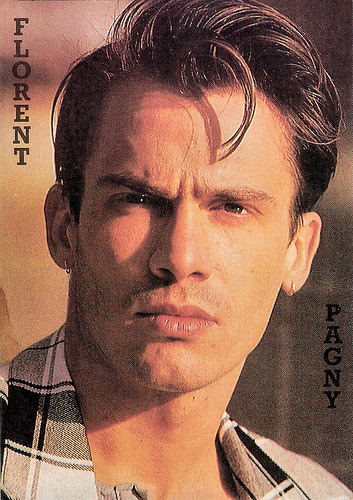
French postcard.
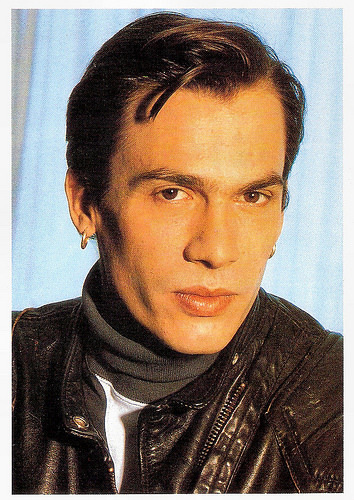
French postcard, no. 519.
A New Life
Florent Pagny decided to go live in Patagonia in order to escape the French tax authorities.
He started a new life with his wife, Argentinian painter Azucena. They had two children, a son Inca and a daughter, Ael. Recently, Pagny said he had enrolled his children in Miami because he didn't want them to speak Arabic while returning from school.
His next album, Savoir aimer, was released in 1997. It was composed by a number of writers, including Jean-Jacques Goldman, Erick Benzi, Jacques Veneruso, Zazie and, Pascal Obispo, who also produced the album. Savoir aimer turned out to be an immediate success.
In 1999, Pagny released an album of cover versions of his old song, Recréation. Pagny then alternated studios and cover albums (at least in part) and regularly changed his look.
In 2000, he released the album Châtelet Les Halles, whose title song was produced by Calogero. He followed that with 2, an album composed of duets released in 2001.
In 2003, he returned with Ailleurs land. Its first single, Ma Liberté de penser, was composed by Pascal Obispo and Lionel Florence and deals with Pagny's problems with the French treasury.
In 2004, Pagny released Baryton, an album composed of opera songs, and in 2007 followed an album of covers of songs originally composed and performed by Jacques Brel entitled Pagny chante Brel. His latest album is Vieillir avec toi (2013). As of 2013, he has sold more than 5 million copies of singles, 10 million copies of albums, becoming the 17th best selling artist in France from 1955 to 2013.
Florent Pagny sings Savoir Aimer. Source: FlorentPagny VEVO (YouTube).
Florent Pagny performs Caruso. Source: FlorentPagny VEVO (YouTube).
Sources: Wikipedia (English), and .

French postcard, no. 1152.

French postcard, no. C 101.
Controversy and boycot
Florent Pagny was born in Chalon-sur-Saône, France in 1961.
Pagny began his career as an extra in such films as the comedy Les surdoués de la première compagnie/The gifted of the first company (Michel Gérard, 1981), and the romance L'amour nu/The naked love (Yannick Bellon, 1981) with Marlène Jobert .
On TV he appeared in the drama series Les maupas (Jean-François Toussaint, 1982) with Yves Rénier, and Marion (Jean Pignol, 1982) featuring Mylène Demongeot .
He played a boxer in the adventure comedy L'as des as (Gérard Oury, 1982) starring Jean-Paul Belmondo .
He also played supporting roles in other popular films like La Balance (Bob Swaim, 1982) with Nathalie Baye, and the historical war drama Fort Saganne (Alain Corneau, 1984) with Gérard Depardieu and Catherine Deneuve .
Pagny had his first lead role in the musical drama Blessure (Michel Gérard, 1985). Interesting is also the Romanian film François Villon - Poetul vagabond/François Villon: The Maverick Poet (Sergiu Nicolaescu, 1987), in which Pagny played the title character.
In 1987, he wrote his first song N'importe quoi. He was discovered by artistic agent Dominique Besnehard, who gave him a record contract.
He continued working as an actor, such as in La fille des collines/The girl from the hills (Robin Davis, 1990).
Pagny's first album, Merci, was released in 1990. The album's songs, mainly written by himself, began to attract controversy, with the press eventually boycotting some of them. This led to a decline in sales, culminating in personal problems.
His follow-up album, Réaliste, was also not successful. He also made headlines because his love affair with singer-actress Vanessa Paradis .
Jean-Jacques Goldman wrote three songs for Pagny under the pseudonym Sam Brewski, and presented to him a new staff.
The album Rester vrai marked the beginning of his career as a performer only. Bienvenue chez moi, a semi-compilation released in 1995, was a smash success. Pagny also covered Caruso, the hit originally performed by Lucio Dalla.

French postcard.

French postcard, no. 519.
A New Life
Florent Pagny decided to go live in Patagonia in order to escape the French tax authorities.
He started a new life with his wife, Argentinian painter Azucena. They had two children, a son Inca and a daughter, Ael. Recently, Pagny said he had enrolled his children in Miami because he didn't want them to speak Arabic while returning from school.
His next album, Savoir aimer, was released in 1997. It was composed by a number of writers, including Jean-Jacques Goldman, Erick Benzi, Jacques Veneruso, Zazie and, Pascal Obispo, who also produced the album. Savoir aimer turned out to be an immediate success.
In 1999, Pagny released an album of cover versions of his old song, Recréation. Pagny then alternated studios and cover albums (at least in part) and regularly changed his look.
In 2000, he released the album Châtelet Les Halles, whose title song was produced by Calogero. He followed that with 2, an album composed of duets released in 2001.
In 2003, he returned with Ailleurs land. Its first single, Ma Liberté de penser, was composed by Pascal Obispo and Lionel Florence and deals with Pagny's problems with the French treasury.
In 2004, Pagny released Baryton, an album composed of opera songs, and in 2007 followed an album of covers of songs originally composed and performed by Jacques Brel entitled Pagny chante Brel. His latest album is Vieillir avec toi (2013). As of 2013, he has sold more than 5 million copies of singles, 10 million copies of albums, becoming the 17th best selling artist in France from 1955 to 2013.
Florent Pagny sings Savoir Aimer. Source: FlorentPagny VEVO (YouTube).
Florent Pagny performs Caruso. Source: FlorentPagny VEVO (YouTube).
Sources: Wikipedia (English), and .
Published on June 22, 2014 23:00
June 21, 2014
Paul Lukas
Paul Lukas (1891-1971) was a Hungarian-born American actor. He had a successful stage and film career in Hungary, Germany and Austria, where he worked with Max Reinhardt. In 1927, he arrived in Hollywood. At first, he played elegant, smooth womanizers, but increasingly he became typecast as a villain. In 1943 he won the Oscar for Best Actor in Watch on the Rhine.
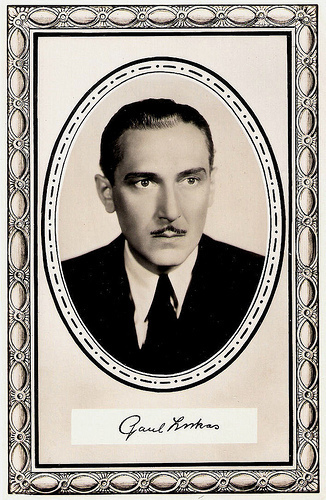
British postcard in the Autograph Series, London, no. A 11.
Matinee Idol
Paul Lukas was born Pál Lukács (native form is Lukács Pál) in Budapest, Austria-Hungary in 1891. He was the son of Naria (née Zilahy) and Janos Lukacs, an advertising executive. His family was Jewish.
He graduated from the Hungarian School for Drama, but in 1913, he had to serve in the Hungarian army. In 1915, he was invalided out.
He went to Kosice (Kassa) to be an actor. Soon he became a matinee idol, and in 1917, he made his film debut in Sphynx/Sphinx (Béla Balogh, 1918).
Among his other Hungarian films are Udvari levegö/Song of the Heart (Béla Balogh, 1918) and Masamód/The Milliner (László Márkus, 1920) with Ica von Lenkeffy.
Between 1918 and 1927, he was a member of the Comedy Theatre in Budapest. Legendary stage director Max Reinhardt also had him guest-star in Berlin and Vienna stage productions.
In Austria, he also co-starred in the silent film epic Samson und Delila/Samson and Delilah (Alexander Korda, 1922). This was the first film to be made at the Rosenhügel Film Studios, which were still under construction at the time and was among the first epic films to be made in Austria. Delilah was played by Maria Corda , the director’s wife.
The film was a failure and both the Kordas and Lukas moved to Germany. There they made the silent drama Das unbekannte Morgen/The Unknown Tomorrow (Alexander Korda, 1923) starring Werner Krauss , María Corda and Olga Limburg. Lukas played a minor role. The film was a financial success, and Korda used his share of the profits to buy a stake in the film distribution company FIHAG.
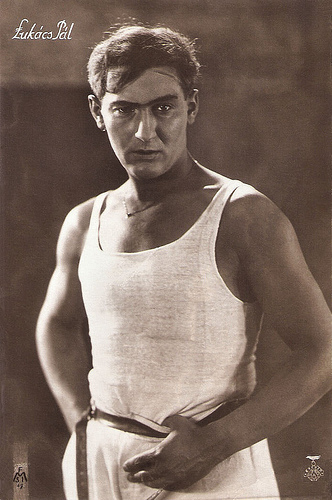
Hungarian postcard by FMSI, no.17. Photo: Korvin / Joe May Film.
Ultra-dutiful Valet
In 1927 Paul Lukas was invited by Hollywood producer Adolph Zukor to come to the US. His American film debut was delayed while he learned English. He made his first American appearance in the silent film Two Lovers (Fred Niblo, 1928).
Next he co-starred with other ex-pats Pola Negri and Olga Baclanova in Three Sinners (Rowland V. Lee, 1928). The film was produced by Famous Players-Lasky and distributed by Paramount Pictures. It is based on a play Das Zweite Leben (or The Second Life) by Rudolf Bernauer and Rudolf Osterreicher.
That year, Lukas also worked again with Korda at the drama The Night Watch (Alexander Korda, 1928), which was set almost entirely on a French warship at the beginning of the First World War. Although largely a silent film. The Night Watch was the first of Korda's films to feature sound effects and music but no dialogue.
Lukas was busy in the early 1930s, appearing in such films as the crime caper Grumpy (George Cukor, Cyril Gardner, 1930), the early film noir City Streets (Rouben Mamoulian, 1931) starring Gary Cooper, the suspense film The Kiss Before the Mirror (James Whale, 1933), starring Nancy Carroll, and the box office hit Little Women (George Cukor, 1933) starring Katharine Hepburn.
Another gem was the elegant comedy By Candlelight (James Whale, 1935). Hal Erickson at AllMovie : “Though quite miscast, Paul Lukas successfully conveys the role of Josef, ultra-dutiful valet to the libidinous Count Von Bommer ( Nils Asther ). Falling in love with Marie ( Elissa Landi ), whom he assumes to be a countess, Josef poses - quite convincingly - as his rakish master. The catch: Marie is herself a poseur, a mere maidservant to Count and Countess Von Rischenheim (Lawrence Grant, Dorothy Revier). Based on a play by Siegfried Geyer, By Candlelight is chock full of delightfully double-entendre pre-Code dialogue and dextrous directorial touches.”
Lukas followed William Powell and Basil Rathbone portraying the series detective Philo Vance once in The Casino Murder Case (Edwin L. Marin, 1935). A success was the drama Dodsworth (William Wyler, 1936).
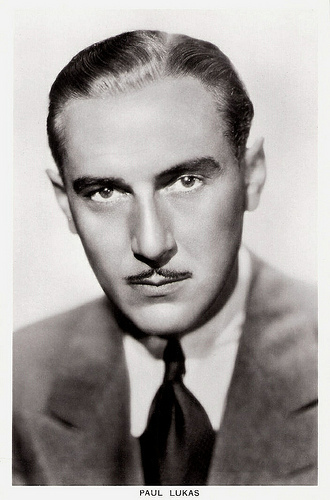
British postcard in the Picturegoer Series, London, no. 661.
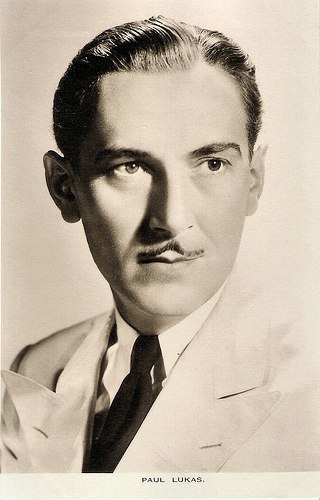
British postcard.
The Sinister Nazi
Paul Lukas became a naturalized citizen of the United States in 1937.
In England he appeared at the mysterious and charming Dr. Hartz in Alfred Hitchcock's classic comic thriller The Lady Vanishes (1938) starring Margaret Lockwood and Michael Redgrave .
In the late 1930s and 1940s Lukas frequently played the sinister Nazi. Another example is Dr. Kassel, the propaganda chief in the patriotic wartime melodrama Confessions of a Nazi Spy (Anatole Litvak, 1939) with Edward G. Robinson and Francis Lederer .
His greatest film role came in Watch on the Rhine (Herman Shumlin, 1943). His portrayal of Kurt Mueller, the German émigré with an American wife (Bette Davis) working against the Nazis was universally lauded by critics. He had originated the role in the Broadway premiere of the play by Lilian Hellman in 1941. He won the Academy Award and the Golden Globe for Best Actor for the role.
In the same year, he guest starred as the eponymous character in an episode of the radio program Suspense, Mr. Markham, Antique Dealer. In the 1940s, Lukas was a charter member of the Motion Picture Alliance for the Preservation of American Ideals, a conservative lobbying group opposed to possible Communist influence in Hollywood.
In the 1950s he started appearing on stage more and more, and worked only sporadically for the cinema. Well known is his role as Professor Aronnax in Walt Disney's film version of Jules Verne's 20,000 Leagues Under the Sea (Richard Fleischer, 1954). By that time, however, he was, at age 63, suffering from memory problems during the production, apparently leading him to lash out at cast and crew alike.
His film career picked up momentum in the 1960s with six films, including the musical Fun in Acapulco (Richard Thorpe, 1963) with Elvis Presley, and the adventure film Lord Jim (Richard Brooks, 1965) with Peter O'Toole . His final film was The Challenge (1970). Director George McGowan chose to hide his involvement by using the pseudonym Alan Smithee.
Paul Lukas died in 1971 in Tangier, Morocco, reportedly while searching for a place to spend his retirement years. He was 80.
Lukas had been married three times. His first Hungarian wife is unknown. His second wife was Gizella ‘Daisy’ Benes (1927–1962; her death) and his last wife was Annette M. Driesens (1963–1971; his death).
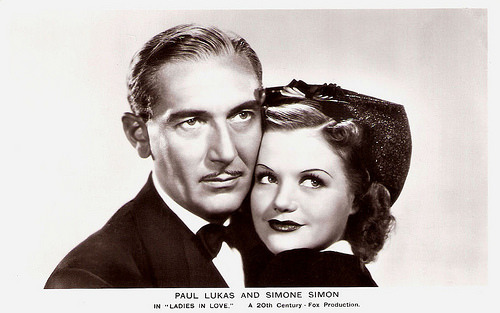
British postcard by Real Photograph, London, no. FS 101. Photo: 20th Century Fox. Publicity still for Ladies in Love (Edward H. Griffith, 1936) with Simone Simon .
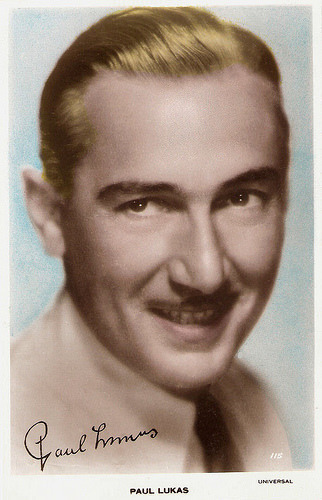
British Art Photo postcard, no. 115. Photo: Universal.
Sources: Hal Erickson (AllMovie), Ronald Bowers (Film Reference), Encyclopaedia Britannica, AllMovie, Wikipedia, and .

British postcard in the Autograph Series, London, no. A 11.
Matinee Idol
Paul Lukas was born Pál Lukács (native form is Lukács Pál) in Budapest, Austria-Hungary in 1891. He was the son of Naria (née Zilahy) and Janos Lukacs, an advertising executive. His family was Jewish.
He graduated from the Hungarian School for Drama, but in 1913, he had to serve in the Hungarian army. In 1915, he was invalided out.
He went to Kosice (Kassa) to be an actor. Soon he became a matinee idol, and in 1917, he made his film debut in Sphynx/Sphinx (Béla Balogh, 1918).
Among his other Hungarian films are Udvari levegö/Song of the Heart (Béla Balogh, 1918) and Masamód/The Milliner (László Márkus, 1920) with Ica von Lenkeffy.
Between 1918 and 1927, he was a member of the Comedy Theatre in Budapest. Legendary stage director Max Reinhardt also had him guest-star in Berlin and Vienna stage productions.
In Austria, he also co-starred in the silent film epic Samson und Delila/Samson and Delilah (Alexander Korda, 1922). This was the first film to be made at the Rosenhügel Film Studios, which were still under construction at the time and was among the first epic films to be made in Austria. Delilah was played by Maria Corda , the director’s wife.
The film was a failure and both the Kordas and Lukas moved to Germany. There they made the silent drama Das unbekannte Morgen/The Unknown Tomorrow (Alexander Korda, 1923) starring Werner Krauss , María Corda and Olga Limburg. Lukas played a minor role. The film was a financial success, and Korda used his share of the profits to buy a stake in the film distribution company FIHAG.

Hungarian postcard by FMSI, no.17. Photo: Korvin / Joe May Film.
Ultra-dutiful Valet
In 1927 Paul Lukas was invited by Hollywood producer Adolph Zukor to come to the US. His American film debut was delayed while he learned English. He made his first American appearance in the silent film Two Lovers (Fred Niblo, 1928).
Next he co-starred with other ex-pats Pola Negri and Olga Baclanova in Three Sinners (Rowland V. Lee, 1928). The film was produced by Famous Players-Lasky and distributed by Paramount Pictures. It is based on a play Das Zweite Leben (or The Second Life) by Rudolf Bernauer and Rudolf Osterreicher.
That year, Lukas also worked again with Korda at the drama The Night Watch (Alexander Korda, 1928), which was set almost entirely on a French warship at the beginning of the First World War. Although largely a silent film. The Night Watch was the first of Korda's films to feature sound effects and music but no dialogue.
Lukas was busy in the early 1930s, appearing in such films as the crime caper Grumpy (George Cukor, Cyril Gardner, 1930), the early film noir City Streets (Rouben Mamoulian, 1931) starring Gary Cooper, the suspense film The Kiss Before the Mirror (James Whale, 1933), starring Nancy Carroll, and the box office hit Little Women (George Cukor, 1933) starring Katharine Hepburn.
Another gem was the elegant comedy By Candlelight (James Whale, 1935). Hal Erickson at AllMovie : “Though quite miscast, Paul Lukas successfully conveys the role of Josef, ultra-dutiful valet to the libidinous Count Von Bommer ( Nils Asther ). Falling in love with Marie ( Elissa Landi ), whom he assumes to be a countess, Josef poses - quite convincingly - as his rakish master. The catch: Marie is herself a poseur, a mere maidservant to Count and Countess Von Rischenheim (Lawrence Grant, Dorothy Revier). Based on a play by Siegfried Geyer, By Candlelight is chock full of delightfully double-entendre pre-Code dialogue and dextrous directorial touches.”
Lukas followed William Powell and Basil Rathbone portraying the series detective Philo Vance once in The Casino Murder Case (Edwin L. Marin, 1935). A success was the drama Dodsworth (William Wyler, 1936).

British postcard in the Picturegoer Series, London, no. 661.

British postcard.
The Sinister Nazi
Paul Lukas became a naturalized citizen of the United States in 1937.
In England he appeared at the mysterious and charming Dr. Hartz in Alfred Hitchcock's classic comic thriller The Lady Vanishes (1938) starring Margaret Lockwood and Michael Redgrave .
In the late 1930s and 1940s Lukas frequently played the sinister Nazi. Another example is Dr. Kassel, the propaganda chief in the patriotic wartime melodrama Confessions of a Nazi Spy (Anatole Litvak, 1939) with Edward G. Robinson and Francis Lederer .
His greatest film role came in Watch on the Rhine (Herman Shumlin, 1943). His portrayal of Kurt Mueller, the German émigré with an American wife (Bette Davis) working against the Nazis was universally lauded by critics. He had originated the role in the Broadway premiere of the play by Lilian Hellman in 1941. He won the Academy Award and the Golden Globe for Best Actor for the role.
In the same year, he guest starred as the eponymous character in an episode of the radio program Suspense, Mr. Markham, Antique Dealer. In the 1940s, Lukas was a charter member of the Motion Picture Alliance for the Preservation of American Ideals, a conservative lobbying group opposed to possible Communist influence in Hollywood.
In the 1950s he started appearing on stage more and more, and worked only sporadically for the cinema. Well known is his role as Professor Aronnax in Walt Disney's film version of Jules Verne's 20,000 Leagues Under the Sea (Richard Fleischer, 1954). By that time, however, he was, at age 63, suffering from memory problems during the production, apparently leading him to lash out at cast and crew alike.
His film career picked up momentum in the 1960s with six films, including the musical Fun in Acapulco (Richard Thorpe, 1963) with Elvis Presley, and the adventure film Lord Jim (Richard Brooks, 1965) with Peter O'Toole . His final film was The Challenge (1970). Director George McGowan chose to hide his involvement by using the pseudonym Alan Smithee.
Paul Lukas died in 1971 in Tangier, Morocco, reportedly while searching for a place to spend his retirement years. He was 80.
Lukas had been married three times. His first Hungarian wife is unknown. His second wife was Gizella ‘Daisy’ Benes (1927–1962; her death) and his last wife was Annette M. Driesens (1963–1971; his death).

British postcard by Real Photograph, London, no. FS 101. Photo: 20th Century Fox. Publicity still for Ladies in Love (Edward H. Griffith, 1936) with Simone Simon .

British Art Photo postcard, no. 115. Photo: Universal.
Sources: Hal Erickson (AllMovie), Ronald Bowers (Film Reference), Encyclopaedia Britannica, AllMovie, Wikipedia, and .
Published on June 21, 2014 23:00
June 20, 2014
Heidemarie Hatheyer
Austrian actress Heidemarie Hatheyer (1918-1990) appeared in 43 films between 1938 and 1988. After the war she was forbidden to act in films for some years, because of her work in the Nazi propaganda film Ich klage an/I accuse (Wolfgang Liebeneiner, 1941).
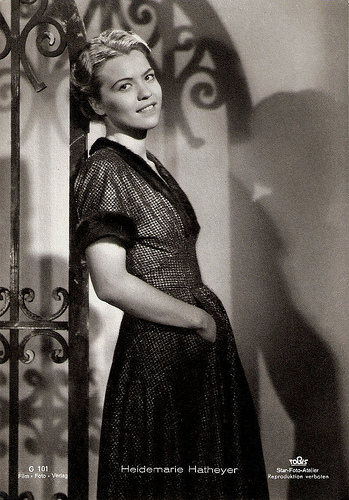
German postcard by Film-Foto-Verlag, no. G 101, 1941-1944. Photo: Star-Foto-Atelier / Tobis.
Wally of the Vultures
Heidemarie Hatheyer was born as Heide Marie Pia Nechansky in Villach, Austria, in 1918. She was born from an extramarital liaison between Mary Feucht née Nechansky and Paul Hatheyer. She grew up in Klagenfurt, where her parents were later married for a time.
After finishing high school she started as a journalist but she went to Vienna to play at the cabaret Atelier am Naschmarkt. Hatheyer joined the Theater an der Wien in 1936. Here she played a small role next to Zarah Leander in the operetta Axel an der Himmelstür (Axel at Heaven’s Gate) with music by Ralph Benatzky and lyrics by Paul Morgan and Hans Weigel.
In 1937 she joined the Münchner Kammerspiele, where she had great success as Anushka in Richard Billinger's play Der Gigant (The Giant) and as Joan in George Bernard Shaw's Heiliger Johanna (Saint Joan). In 1942 Gustav Gründgens asked her for the Preußische Staatstheater in Berlin.
She was discovered for the film by mountaineer filmmaker Luis Trenker . He asked her for the mountain-climbing romance Der Berg ruft!/The Mountain Calls ( Luis Trenker , 1938), in which she became the leading lady.
She signed a contract with Tobis Films, and appeared in Ein ganzer Kerl/A Regular Fellow (Fritz Peter Buch, 1939) opposite Albert Matterstock .
Her title role as a mountain girl in Die Geierwally/Wally of the Vultures (Hans Steinhoff, 1940) became the greatest success of her career.
Till the end of the war she appeared in such well-known films as Der grosse Schatten/The Big Shadow (Paul Verhoeven, 1942) in the role of a pregnant stage ingénue, and Die Jahre vergehen/The Years pass (Günther Rittau, 1944), but she also acted in the Nazi propaganda film Ich klage an/I Accuse ( Wolfgang Liebeneiner , 1941). This film was intended as a preparation and secret promotion for Adolph Hitler's euthanasia program.
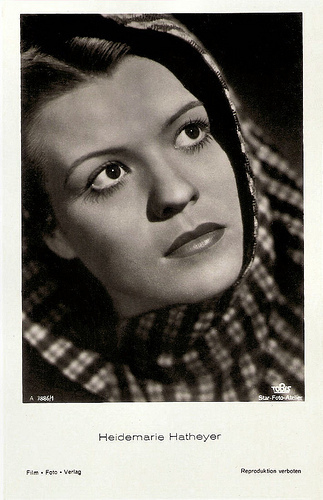
German postcard by Film-Foto-Verlag, no. A 3886/1, 1941-1944. Photo: Star-Foto-Atelier / Tobis.
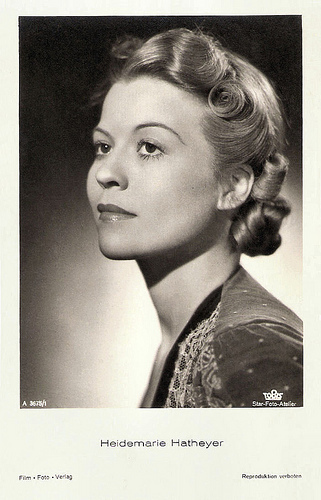
German postcard by Film-Foto-Verlag, no. A 3675/1, 1941-1944. Photo: Star-Foto-Atelier / Tobis.
Blacklist
In 1945, the Allied Military Government forbade Heidemarie Hatheyer to play in films, because of her work on Ich klage an. They declared her guilty of 'indirect complicity' in the mass exterminations that had taken place during the Third Reich. They allowed her to continue working at the theatre, and she played on stage in Germany, Switzerland and Vienna. She claimed to have been forced to play the hopelessly ill victim in the film by its director, Wolfgang Liebeneiner , and the blacklist was lifted in 1949.
During the following decade, she continued her film career successfully. To her well-known films of the 1950s belong Dr. Holl/Affairs of Dr. Holl (Rolf Hansen, 1951), Das letzte Rezept/Desires (Rolf Hansen, 1952) with O.W. Fischer , Pünktchen und Anton/Punktchen and Anton (Thomas Engel, 1953), Sauerbruch - Das war mein Leben/The Life of Surgeon Sauerbruch (Rolf Hansen, 1954), Die Ratten/The Rats (Robert Siodmak, 1955) with Maria Schell , and Glücksritter/A Modern Story (Arthur Maria Rabenalt, 1957) with Paul Hubschmid .
She was from 1960 to 1968 a member of the Burgtheater in Vienna. In 1984 she returned here as a guest.
In 1960, she was awarded the prestigious Josef Kainz Medaille, an award named after the turn-of-the-century German stage star. She was awarded the Filmband in Gold twice, first in 1984 for lifetime achievement, and in 1989 for Best Actress in Martha Jellneck (Kai Wessel, 1988). In this film she played a lonely old woman who unmasks an SS officer.
She played her last role in three episodes of the serial Diese Drombuschs/These Drombuschs (Michael Günther, Michael Werlin, 1989).
In 1990 Heidemarie Hatheyer died in Scheuren bei Forch, Switzerland, aged 72. She was first married to director Willfried Feldhütter and from 1952 on she was married with the author Curt Riess. She had two daughters from her first marriage, Veronica Feldhütter and Regine Feldhütter . The latter with whom she often appeared together in films and on TV, has already died. Her granddaughter is also an actress.
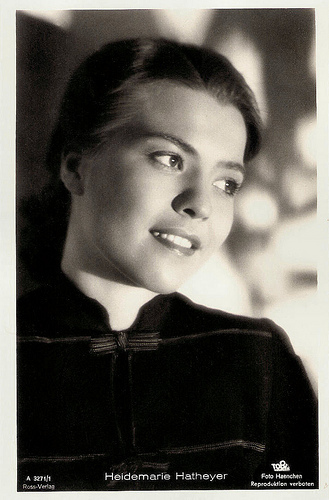
German postcard by Film-Foto-Verlag, no. A 3271/1, 1941-1944. Photo: Haenchen / Tobis.
Scene from Dr. Holl/Affairs of Dr. Holl (1951) with Maria Schell , Dieter Borsche and Heidemarie Hatheyer. Source: LadyViolet07 (YouTube).
Sources: Thomas Staedeli (Cyranos), Hans J. Wollstein (AllMovie), (IMDb), H.M. Bock (Filmportal.de - German), Wikipedia (German) and .

German postcard by Film-Foto-Verlag, no. G 101, 1941-1944. Photo: Star-Foto-Atelier / Tobis.
Wally of the Vultures
Heidemarie Hatheyer was born as Heide Marie Pia Nechansky in Villach, Austria, in 1918. She was born from an extramarital liaison between Mary Feucht née Nechansky and Paul Hatheyer. She grew up in Klagenfurt, where her parents were later married for a time.
After finishing high school she started as a journalist but she went to Vienna to play at the cabaret Atelier am Naschmarkt. Hatheyer joined the Theater an der Wien in 1936. Here she played a small role next to Zarah Leander in the operetta Axel an der Himmelstür (Axel at Heaven’s Gate) with music by Ralph Benatzky and lyrics by Paul Morgan and Hans Weigel.
In 1937 she joined the Münchner Kammerspiele, where she had great success as Anushka in Richard Billinger's play Der Gigant (The Giant) and as Joan in George Bernard Shaw's Heiliger Johanna (Saint Joan). In 1942 Gustav Gründgens asked her for the Preußische Staatstheater in Berlin.
She was discovered for the film by mountaineer filmmaker Luis Trenker . He asked her for the mountain-climbing romance Der Berg ruft!/The Mountain Calls ( Luis Trenker , 1938), in which she became the leading lady.
She signed a contract with Tobis Films, and appeared in Ein ganzer Kerl/A Regular Fellow (Fritz Peter Buch, 1939) opposite Albert Matterstock .
Her title role as a mountain girl in Die Geierwally/Wally of the Vultures (Hans Steinhoff, 1940) became the greatest success of her career.
Till the end of the war she appeared in such well-known films as Der grosse Schatten/The Big Shadow (Paul Verhoeven, 1942) in the role of a pregnant stage ingénue, and Die Jahre vergehen/The Years pass (Günther Rittau, 1944), but she also acted in the Nazi propaganda film Ich klage an/I Accuse ( Wolfgang Liebeneiner , 1941). This film was intended as a preparation and secret promotion for Adolph Hitler's euthanasia program.

German postcard by Film-Foto-Verlag, no. A 3886/1, 1941-1944. Photo: Star-Foto-Atelier / Tobis.

German postcard by Film-Foto-Verlag, no. A 3675/1, 1941-1944. Photo: Star-Foto-Atelier / Tobis.
Blacklist
In 1945, the Allied Military Government forbade Heidemarie Hatheyer to play in films, because of her work on Ich klage an. They declared her guilty of 'indirect complicity' in the mass exterminations that had taken place during the Third Reich. They allowed her to continue working at the theatre, and she played on stage in Germany, Switzerland and Vienna. She claimed to have been forced to play the hopelessly ill victim in the film by its director, Wolfgang Liebeneiner , and the blacklist was lifted in 1949.
During the following decade, she continued her film career successfully. To her well-known films of the 1950s belong Dr. Holl/Affairs of Dr. Holl (Rolf Hansen, 1951), Das letzte Rezept/Desires (Rolf Hansen, 1952) with O.W. Fischer , Pünktchen und Anton/Punktchen and Anton (Thomas Engel, 1953), Sauerbruch - Das war mein Leben/The Life of Surgeon Sauerbruch (Rolf Hansen, 1954), Die Ratten/The Rats (Robert Siodmak, 1955) with Maria Schell , and Glücksritter/A Modern Story (Arthur Maria Rabenalt, 1957) with Paul Hubschmid .
She was from 1960 to 1968 a member of the Burgtheater in Vienna. In 1984 she returned here as a guest.
In 1960, she was awarded the prestigious Josef Kainz Medaille, an award named after the turn-of-the-century German stage star. She was awarded the Filmband in Gold twice, first in 1984 for lifetime achievement, and in 1989 for Best Actress in Martha Jellneck (Kai Wessel, 1988). In this film she played a lonely old woman who unmasks an SS officer.
She played her last role in three episodes of the serial Diese Drombuschs/These Drombuschs (Michael Günther, Michael Werlin, 1989).
In 1990 Heidemarie Hatheyer died in Scheuren bei Forch, Switzerland, aged 72. She was first married to director Willfried Feldhütter and from 1952 on she was married with the author Curt Riess. She had two daughters from her first marriage, Veronica Feldhütter and Regine Feldhütter . The latter with whom she often appeared together in films and on TV, has already died. Her granddaughter is also an actress.

German postcard by Film-Foto-Verlag, no. A 3271/1, 1941-1944. Photo: Haenchen / Tobis.
Scene from Dr. Holl/Affairs of Dr. Holl (1951) with Maria Schell , Dieter Borsche and Heidemarie Hatheyer. Source: LadyViolet07 (YouTube).
Sources: Thomas Staedeli (Cyranos), Hans J. Wollstein (AllMovie), (IMDb), H.M. Bock (Filmportal.de - German), Wikipedia (German) and .
Published on June 20, 2014 23:00
June 19, 2014
Hans Pos (1958-2014)
On Tuesday 17 June, Dutch producer and director Hans Pos died. In 1987, he founded Shooting Star Filmcompany with Maria Peters, and Dave Schram. They produced several popular family films, like Kruimeltje/Little Crumb (Maria Peters, 1999) and Pietje Bell/Peter Bell (Maria Peters, 2002) featuring Quinten Schram. Hans Pos was 56.
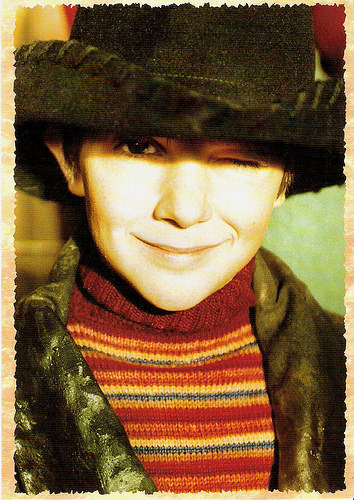
Dutch postcard by Rubinstein. Photo: publicity still for Pietje Bell/Peter Bell (Maria Peters, 2002) featuring Quinten Schram.
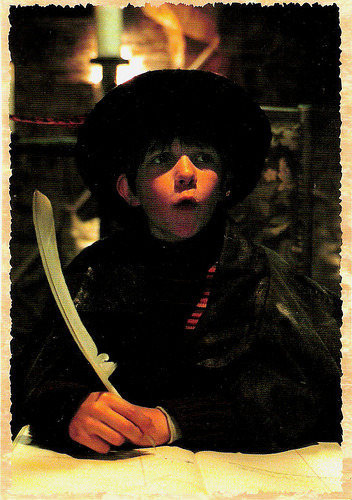
Dutch postcard by Rubinstein. Photo: publicity still for Pietje Bell/Peter Bell (Maria Peters, 2002) featuring Quinten Schram.
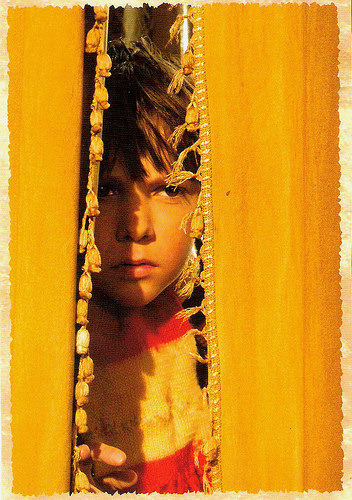
Dutch postcard by Rubinstein. Photo: publicity still for Pietje Bell/Peter Bell (Maria Peters, 2002) featuring Quinten Schram.
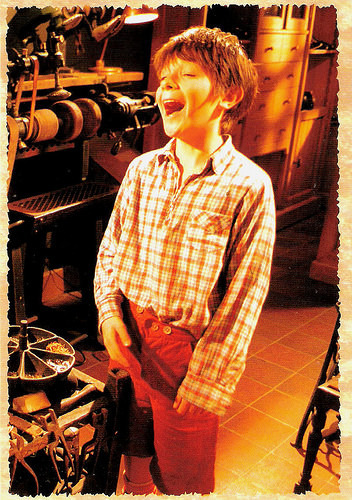
Dutch postcard by Rubinstein. Photo: publicity still for Pietje Bell/Peter Bell (Maria Peters, 2002) featuring Quinten Schram.
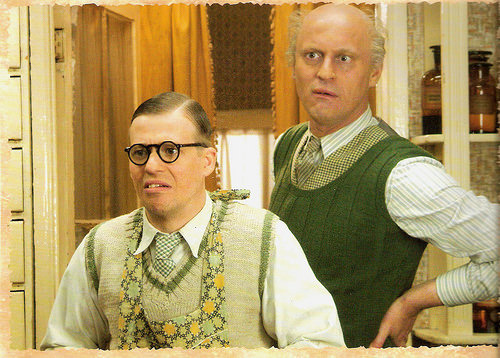
Dutch postcard by Rubinstein. Photo: publicity still for Pietje Bell/Peter Bell (Maria Peters, 2002) featuring Stijn Westenend and Arjan Ederveen.
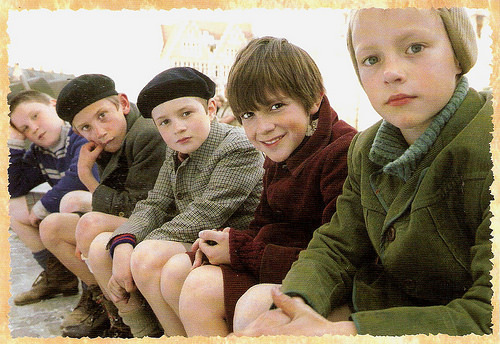
Dutch postcard by Rubinstein. Photo: publicity still for Pietje Bell/Peter Bell (Maria Peters, 2002) featuring Quinten Schram.
Source: .

Dutch postcard by Rubinstein. Photo: publicity still for Pietje Bell/Peter Bell (Maria Peters, 2002) featuring Quinten Schram.

Dutch postcard by Rubinstein. Photo: publicity still for Pietje Bell/Peter Bell (Maria Peters, 2002) featuring Quinten Schram.

Dutch postcard by Rubinstein. Photo: publicity still for Pietje Bell/Peter Bell (Maria Peters, 2002) featuring Quinten Schram.

Dutch postcard by Rubinstein. Photo: publicity still for Pietje Bell/Peter Bell (Maria Peters, 2002) featuring Quinten Schram.

Dutch postcard by Rubinstein. Photo: publicity still for Pietje Bell/Peter Bell (Maria Peters, 2002) featuring Stijn Westenend and Arjan Ederveen.

Dutch postcard by Rubinstein. Photo: publicity still for Pietje Bell/Peter Bell (Maria Peters, 2002) featuring Quinten Schram.
Source: .
Published on June 19, 2014 23:00
Jean-Claude Van Damme
Belgian martial artist and actor Jean-Claude Van Damme (1960) is best known for his Hollywood films of the 1980s and 1990s. His most successful films include Bloodsport (1988), Universal Soldier (1992), and Timecop (1994). But the Belgian crime drama JCVD (2008) gave him his best reviews ever and paved the way for his come-back to the mainstream.

French postcard, no. C 275.
The Muscles from Brussels
Jean-Claude Van Damme (or JCVD) was born Jean-Claude Camille François Van Varenberg in Brussels, Belgium, in 1960. He was the son of Eliana and Eugène Van Varenberg, who was an accountant.
He began martial arts at the age of ten, enrolled by his father in a Shotokan karate school. At the age of 11, Van Damme joined the Centre National De Karaté (National Centre of Karate) under the guidance of Claude Goetz in Belgium.
Van Damme trained for four years and he earned a spot on the Belgian Karate Team. Later he was trained in full-contact karate and kickboxing by Dominique Valera. He eventually earned his black belt in karate.
At the age of 15, Van Damme started his competitive karate career in Belgium. From 1976 to1980, he compiled a record of 44 victories and 4 defeats in tournament and non-tournament semi-contact matches. He started lifting weights to improve his physique, which eventually led to a Mr. Belgium bodybuilding title and the nickname ‘The Muscles from Brussels’.
At the age of 16, he took up ballet, which he studied for five years. According to Van Damme, ballet is an art, but it's also one of the most difficult sports: "If you can survive a ballet workout, you can survive a workout in any other sport."
Van Damme began his full-contact career in 1977, when Claude Goetz promoted the first ever full-contact karate tournament in Belgium. From 1977 to 1982, Van Damme compiled a record of 18 victories (18 knockouts) and 1 defeat. Van Damme retired from competition in 1982.
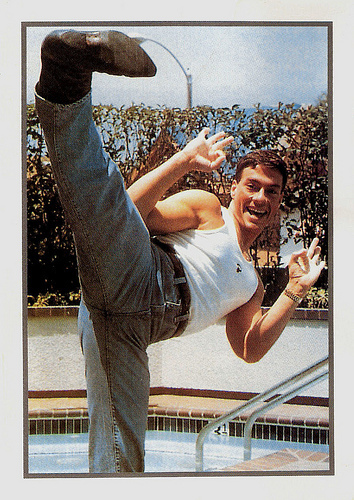
French postcard, no. 1018.
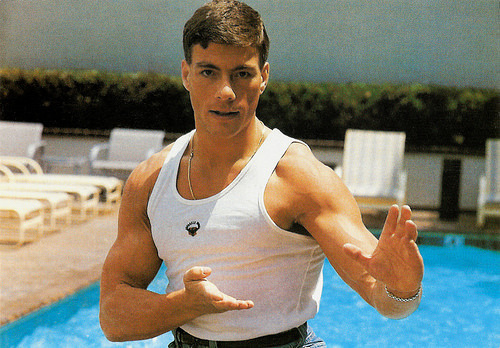
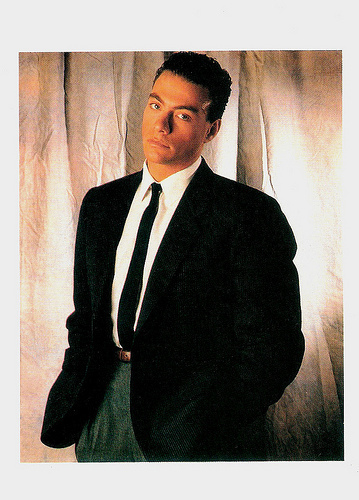
French postcard by Underground, no. C 87.
A new sensational action star
In 1982, Jean-Claude Van Damme and childhood friend, Michel Qissi, moved to America in the hope of becoming action stars. He took English classes while working as carpet layer, pizza delivery man, limo driver, and thanks to Chuck Norris he got a job as a bouncer at a club.
He and Qissi were cast as extras in the break dancing film, Breakin' (Joel Silberg, 1984). Van Damme had his first part as a ‘Gay Karate Man’ in the short film Monaco Forever (William A. Levey, 1984).
After a small part in Missing In Action (Joseph Zitto, 1984), Van Damme was next cast in the low-budget martial arts-film No Retreat, No Surrender/Karate Tiger (Corey Yuen, 1986), as the Russian villain Ivan Kraschinsky. Van Damme worked for director John McTiernan for Predator (1987) as the titular alien, before being removed and replaced by Kevin Peter Hall. He also had a non-speaking part as a Secret Service agent who carries a polio-crippled President Franklin Roosevelt (Ralph Bellamy) out of a pool in the TV miniseries War and Remembrance (1988).
His breakout film was Bloodsport (Newt Arnold, 1988), based on the alleged true story of martial arts artist Frank Dux. He performed numerous physical feats such as helicopter-style, jump spinning heel kicks, and a complete split. Shot on a 1.5 million dollar budget, it became a box-office hit grossing more than 11 million dollar in the US and 30 million world-wide. A new sensational action star was born.
He then starred in Cyborg (Albert Pyun, 1989), shot for less than $500,000 and filmed in 24 days. Despite negative reviews, it became another box-office hit.
Then the films followed rapidly. In Kickboxer (Mark DiSalle, 1989), his character fights to avenge his brother who has been paralyzed by a Thai kickboxing champion (Qissi). In Double Impact (Sheldon Lettich, 1991) he played the dual role of Alex and Chad Wagner, estranged twin brothers fighting to avenge the deaths of their parents. This film reunited him with his Bloodsport co-star, Bolo Yeung.
In the science fiction action film Universal Soldier (Roland Emmerich, 1992), he co-starred with Dolph Lundgren as soldiers who kill each other in Vietnam but are reanimated in a secret Army project along with a large group of other previously dead soldiers. While it grossed $36,299,898 in the US, it was an even bigger success in the rest of the world, making over $65 million. With a modest $23 million budget, it was Van Damme's highest grossing film at the time.
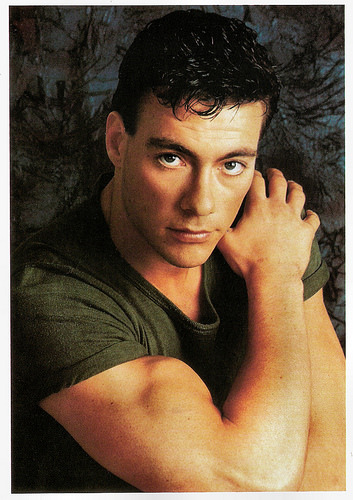
British postcard by Santoro Graphics Ltd., South Yorks, no. C 349.
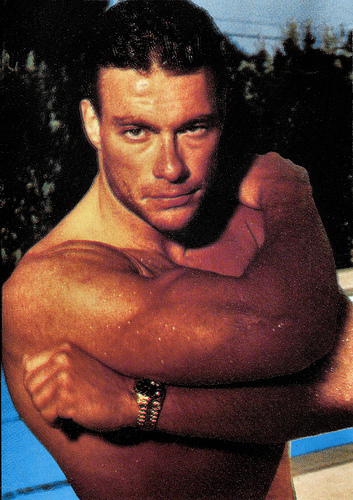
French postcard, no. C 469. Sorry, for the poor technical quality of the card.
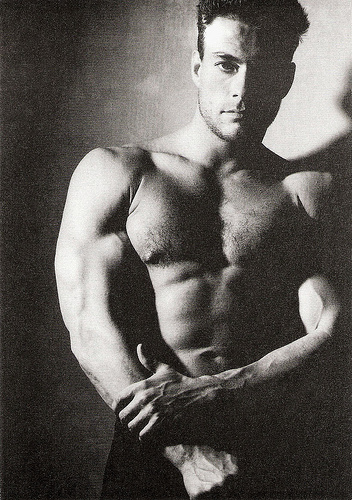
French postcard, réf. 698.
Trouble
Jean-Claude Van Damme starred in the action dramas Nowhere To Run (Robert Harmon, 1993) with Rosanna Arquette, and Hard Target (John Woo, 1993). Again, both were financially successful but received mixed reviews.
In his next film, the science fiction action film Timecop (Peter Hyams, 1994),Van Damme played a time travelling cop, who tries to prevent the death of his wife (Mia Sara). With a box office of over $100 million worldwide Timecop remains Van Damme's highest grossing film in a lead role to date and is also generally regarded as one of his better films by critics.
After this huge success, Street Fighter (Steven E. de Souza, 1994) with Raul Julia was universally panned by critics and fans of the video game series alike, but it was another commercial success. Sudden Death (Peter Hyams, 1995) did fairly well and was considered one of his best films to date.
Then Van Damme’s projects started to fail at the box office. The Quest (Jean-Claude Van Damme, 1996) with Roger Moore , Maximum Risk (Ringo Lam, 1996) – again in a double role, Double Team (Tsui Hark, 1997) with basketball star Dennis Rodman, and Knock Off (Tsui Hark, 1998) were all box-office flops.
There was more trouble. The stress led him to develop a cocaine habit, on which he spent up to $10,000 a week, and consuming up to 10 grams per day by 1996. In 1997, Frank Dux, the martial artist whom Van Damme portrayed in Bloodsport, filed a lawsuit against Van Damme for $50,000 for co-writing and consultation work Dux did on The Quest. According to the lawsuit, Dux also accused Van Damme of lying to the public about his martial arts fight record. Van Damme won the court case.
Van Damme’s next film Universal Soldier: The Return (Mic Rodgers, 1999) was again a box-office flop, and his last theatrically released film until 2008. Van Damme was arrested for driving under the influence in 1999. Attempts at drug rehabilitation were unsuccessful, and he resorted to resolve his addiction via quitting cold turkey and exercise.

French postcard, no. C 345.
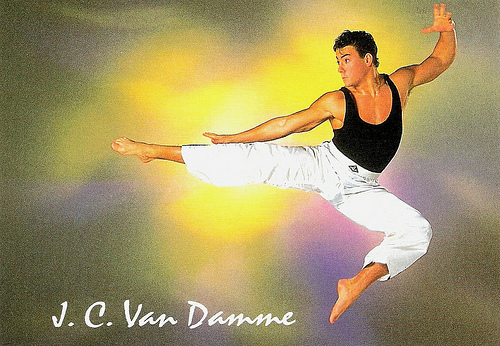
Italian postcard by World Collection, no. 322. Photo: G. Neri.
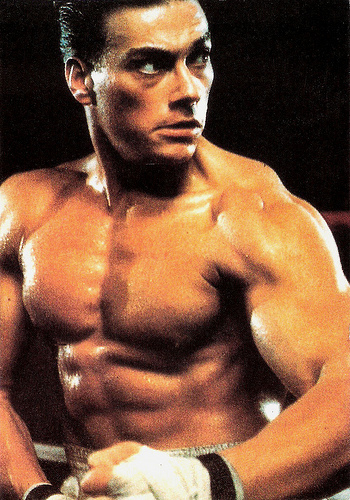
French postcard, no. 2089.
The return of the veteran action stars
Jean-Claude Van Damme returned to the mainstream with the Belgian crime drama JCVD (Mabrouk El Mechri, 2008). He played a down and out action star whose family and career are crumbling around him as he is caught in the middle of a post office heist in his hometown of Brussels, Belgium.
The film was screened at various festivals and Time Magazine named Van Damme's performance in the film the second best of the year (after Heath Ledger's The Joker in The Dark Knight). According to Time , he even deserved an Oscar.
Van Damme reprised his role as Luc Deveraux in Universal Soldier: Regeneration (John Hyams (2009), directed by John Hyams, son of Peter Hyams. Sylvester Stallone offered him a lead role in The Expendables (2010), but Van Damme turned it down.
He voiced Master Croc in Kung Fu Panda 2 (Jennifer Yuh Nelson, 2011), the highest grossing animated feature film of the year. He also appeared in commercials for Coors Light beer, showing him on a snow-covered mountain wearing a sleeveless denim jacket, and for the washing powder Dash.
He returned to the Universal Soldier series with Universal Soldier: Day of Reckoning (John Hyams, 2012), again opposite Dolph Lundgren. Then he did participate with Stallone in The Expendables 2 (Simon West, 2012), along with other veteran action stars as Bruce Willis, Arnold Schwarzenegger and Dolph Lundgren.
That year he was honoured with a life-size statue of himself in his hometown of Brussels. Van Damme has been married five times to four different women. His first two wives were Maria Rodriguez (1980-1984) and Cynthia Derderian (1985-1986). He was married to his third wife, bodybuilder Gladys Portugues, until 1992, when he began an affair with actress Darcy LaPier, whom he married in February 1994. That same year he had an affair with his Street Fighter co-star Kylie Minogue during filming in Thailand, though LaPier, who was pregnant at the time with their son Nicholas, did not become aware of this until Van Damme publicly admitted this in 2012.
After leaving LaPier, Van Damme remarried bodybuilder Portugues, in 1999. They have two children: Kristopher van Varenberg (1987) and Bianca Bree (1990). He appeared with both children in the action film Six Bullets (Ernie Barbarash, 2012).
Van Damme has been planning to make a comeback to fight former boxing Olympic gold-medalist Somluck Kamsing. The fight was a focal point in his ITV reality show Jean Claude Van Damme: Behind Closed Doors. However, the fight has been repeatedly postponed, and critics doubt it will ever occur.
But no worries, the Muscles of Brussels keeps himself busy and three new films with him are scheduled for 2014.
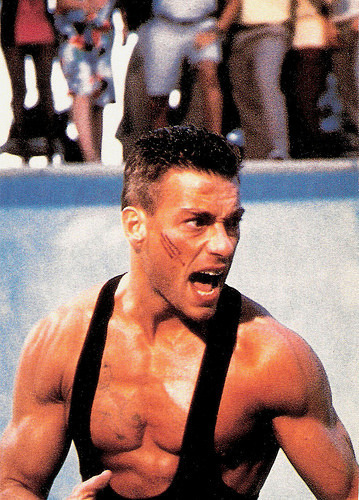
British postcard by Oliver Books, London, no. 52.
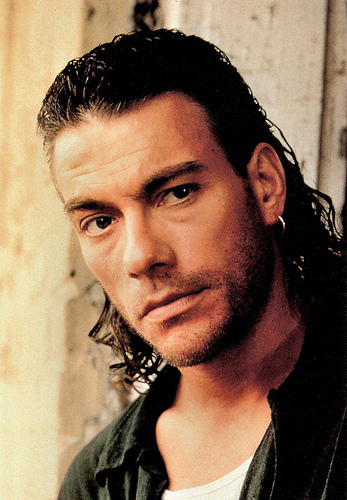
British postcard by Heroes Publishing, London, no. SPC 2500.
Sources: Wikipedia and .

French postcard, no. C 275.
The Muscles from Brussels
Jean-Claude Van Damme (or JCVD) was born Jean-Claude Camille François Van Varenberg in Brussels, Belgium, in 1960. He was the son of Eliana and Eugène Van Varenberg, who was an accountant.
He began martial arts at the age of ten, enrolled by his father in a Shotokan karate school. At the age of 11, Van Damme joined the Centre National De Karaté (National Centre of Karate) under the guidance of Claude Goetz in Belgium.
Van Damme trained for four years and he earned a spot on the Belgian Karate Team. Later he was trained in full-contact karate and kickboxing by Dominique Valera. He eventually earned his black belt in karate.
At the age of 15, Van Damme started his competitive karate career in Belgium. From 1976 to1980, he compiled a record of 44 victories and 4 defeats in tournament and non-tournament semi-contact matches. He started lifting weights to improve his physique, which eventually led to a Mr. Belgium bodybuilding title and the nickname ‘The Muscles from Brussels’.
At the age of 16, he took up ballet, which he studied for five years. According to Van Damme, ballet is an art, but it's also one of the most difficult sports: "If you can survive a ballet workout, you can survive a workout in any other sport."
Van Damme began his full-contact career in 1977, when Claude Goetz promoted the first ever full-contact karate tournament in Belgium. From 1977 to 1982, Van Damme compiled a record of 18 victories (18 knockouts) and 1 defeat. Van Damme retired from competition in 1982.

French postcard, no. 1018.


French postcard by Underground, no. C 87.
A new sensational action star
In 1982, Jean-Claude Van Damme and childhood friend, Michel Qissi, moved to America in the hope of becoming action stars. He took English classes while working as carpet layer, pizza delivery man, limo driver, and thanks to Chuck Norris he got a job as a bouncer at a club.
He and Qissi were cast as extras in the break dancing film, Breakin' (Joel Silberg, 1984). Van Damme had his first part as a ‘Gay Karate Man’ in the short film Monaco Forever (William A. Levey, 1984).
After a small part in Missing In Action (Joseph Zitto, 1984), Van Damme was next cast in the low-budget martial arts-film No Retreat, No Surrender/Karate Tiger (Corey Yuen, 1986), as the Russian villain Ivan Kraschinsky. Van Damme worked for director John McTiernan for Predator (1987) as the titular alien, before being removed and replaced by Kevin Peter Hall. He also had a non-speaking part as a Secret Service agent who carries a polio-crippled President Franklin Roosevelt (Ralph Bellamy) out of a pool in the TV miniseries War and Remembrance (1988).
His breakout film was Bloodsport (Newt Arnold, 1988), based on the alleged true story of martial arts artist Frank Dux. He performed numerous physical feats such as helicopter-style, jump spinning heel kicks, and a complete split. Shot on a 1.5 million dollar budget, it became a box-office hit grossing more than 11 million dollar in the US and 30 million world-wide. A new sensational action star was born.
He then starred in Cyborg (Albert Pyun, 1989), shot for less than $500,000 and filmed in 24 days. Despite negative reviews, it became another box-office hit.
Then the films followed rapidly. In Kickboxer (Mark DiSalle, 1989), his character fights to avenge his brother who has been paralyzed by a Thai kickboxing champion (Qissi). In Double Impact (Sheldon Lettich, 1991) he played the dual role of Alex and Chad Wagner, estranged twin brothers fighting to avenge the deaths of their parents. This film reunited him with his Bloodsport co-star, Bolo Yeung.
In the science fiction action film Universal Soldier (Roland Emmerich, 1992), he co-starred with Dolph Lundgren as soldiers who kill each other in Vietnam but are reanimated in a secret Army project along with a large group of other previously dead soldiers. While it grossed $36,299,898 in the US, it was an even bigger success in the rest of the world, making over $65 million. With a modest $23 million budget, it was Van Damme's highest grossing film at the time.

British postcard by Santoro Graphics Ltd., South Yorks, no. C 349.

French postcard, no. C 469. Sorry, for the poor technical quality of the card.

French postcard, réf. 698.
Trouble
Jean-Claude Van Damme starred in the action dramas Nowhere To Run (Robert Harmon, 1993) with Rosanna Arquette, and Hard Target (John Woo, 1993). Again, both were financially successful but received mixed reviews.
In his next film, the science fiction action film Timecop (Peter Hyams, 1994),Van Damme played a time travelling cop, who tries to prevent the death of his wife (Mia Sara). With a box office of over $100 million worldwide Timecop remains Van Damme's highest grossing film in a lead role to date and is also generally regarded as one of his better films by critics.
After this huge success, Street Fighter (Steven E. de Souza, 1994) with Raul Julia was universally panned by critics and fans of the video game series alike, but it was another commercial success. Sudden Death (Peter Hyams, 1995) did fairly well and was considered one of his best films to date.
Then Van Damme’s projects started to fail at the box office. The Quest (Jean-Claude Van Damme, 1996) with Roger Moore , Maximum Risk (Ringo Lam, 1996) – again in a double role, Double Team (Tsui Hark, 1997) with basketball star Dennis Rodman, and Knock Off (Tsui Hark, 1998) were all box-office flops.
There was more trouble. The stress led him to develop a cocaine habit, on which he spent up to $10,000 a week, and consuming up to 10 grams per day by 1996. In 1997, Frank Dux, the martial artist whom Van Damme portrayed in Bloodsport, filed a lawsuit against Van Damme for $50,000 for co-writing and consultation work Dux did on The Quest. According to the lawsuit, Dux also accused Van Damme of lying to the public about his martial arts fight record. Van Damme won the court case.
Van Damme’s next film Universal Soldier: The Return (Mic Rodgers, 1999) was again a box-office flop, and his last theatrically released film until 2008. Van Damme was arrested for driving under the influence in 1999. Attempts at drug rehabilitation were unsuccessful, and he resorted to resolve his addiction via quitting cold turkey and exercise.

French postcard, no. C 345.

Italian postcard by World Collection, no. 322. Photo: G. Neri.

French postcard, no. 2089.
The return of the veteran action stars
Jean-Claude Van Damme returned to the mainstream with the Belgian crime drama JCVD (Mabrouk El Mechri, 2008). He played a down and out action star whose family and career are crumbling around him as he is caught in the middle of a post office heist in his hometown of Brussels, Belgium.
The film was screened at various festivals and Time Magazine named Van Damme's performance in the film the second best of the year (after Heath Ledger's The Joker in The Dark Knight). According to Time , he even deserved an Oscar.
Van Damme reprised his role as Luc Deveraux in Universal Soldier: Regeneration (John Hyams (2009), directed by John Hyams, son of Peter Hyams. Sylvester Stallone offered him a lead role in The Expendables (2010), but Van Damme turned it down.
He voiced Master Croc in Kung Fu Panda 2 (Jennifer Yuh Nelson, 2011), the highest grossing animated feature film of the year. He also appeared in commercials for Coors Light beer, showing him on a snow-covered mountain wearing a sleeveless denim jacket, and for the washing powder Dash.
He returned to the Universal Soldier series with Universal Soldier: Day of Reckoning (John Hyams, 2012), again opposite Dolph Lundgren. Then he did participate with Stallone in The Expendables 2 (Simon West, 2012), along with other veteran action stars as Bruce Willis, Arnold Schwarzenegger and Dolph Lundgren.
That year he was honoured with a life-size statue of himself in his hometown of Brussels. Van Damme has been married five times to four different women. His first two wives were Maria Rodriguez (1980-1984) and Cynthia Derderian (1985-1986). He was married to his third wife, bodybuilder Gladys Portugues, until 1992, when he began an affair with actress Darcy LaPier, whom he married in February 1994. That same year he had an affair with his Street Fighter co-star Kylie Minogue during filming in Thailand, though LaPier, who was pregnant at the time with their son Nicholas, did not become aware of this until Van Damme publicly admitted this in 2012.
After leaving LaPier, Van Damme remarried bodybuilder Portugues, in 1999. They have two children: Kristopher van Varenberg (1987) and Bianca Bree (1990). He appeared with both children in the action film Six Bullets (Ernie Barbarash, 2012).
Van Damme has been planning to make a comeback to fight former boxing Olympic gold-medalist Somluck Kamsing. The fight was a focal point in his ITV reality show Jean Claude Van Damme: Behind Closed Doors. However, the fight has been repeatedly postponed, and critics doubt it will ever occur.
But no worries, the Muscles of Brussels keeps himself busy and three new films with him are scheduled for 2014.

British postcard by Oliver Books, London, no. 52.

British postcard by Heroes Publishing, London, no. SPC 2500.
Sources: Wikipedia and .
Published on June 19, 2014 09:13
June 17, 2014
Seymour Hicks
Suave Seymour Hicks (1871-1949) was a successful British actor, music hall performer, playwright, screenwriter, actor-manager and producer. He became known, early in his career, for writing, starring in and producing several Edwardian musical comedies, often together with his famous wife, Ellaline Terriss. His most popular role was that of Ebenezer Scrooge in Charles Dickens's A Christmas Carol. He repeated this role on screen in a silent and a sound version.
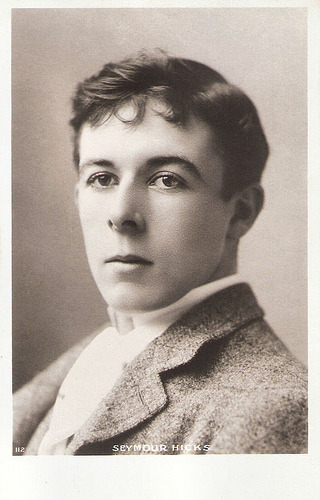
British postcard, no. 112.
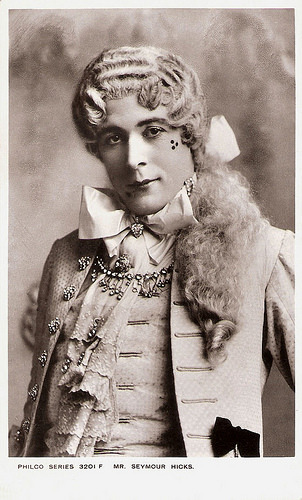
British postcard in the Philco Series, no. 3201 F.
An Unaccustomed Light-hearted Air
Edward Seymour Hicks was born in St. Hélier on the Isle of Jersey, Great-Britain in 1871. He made his stage début at the age of nine. He appeared as Little Buttercup in Gilbert and Sullivan's H.M.S. Pinafore at his school in Bath. After that, he was determined to be an actor.
Hicks first appeared professionally on stage at the age of sixteen in a production of In the Ranks at the Grand, Islington. In 1889, he joined the theatrical company of Mr. and Mrs. Kendal for an American tour where they presented a repertory of contemporary plays.
Hicks starred as Dr. Watson in a parody of Sherlock Holmes, Under the Clock (1893) at the Royal Court Theatre. It was written by Hicks with Charles Brookfield, who played Holmes, and it was the first musical revue ever staged in London. That same year, he married Ellaline Terriss.
Then he starred in a revival of Little Jack Sheppard at the Gaiety Theatre, London which brought him to the attention of impresario George Edwardes. Edwardes cast Hicks in his next show, The Shop Girl (1894) opposite Ada Reeve . Kurt Gänzl in The Encyclopaedia of Musical Theatre : “The pair, comedy players both, gave an unaccustomed light-hearted air to the show's juvenile roles for, until that time, sentimentality rather than fun had been de rigueur in such parts, and Hicks scored a hit with the first of the many borrowed songs he would perform in shows over the years, Felix McGlennon's Her Golden Hair Was Hanging Down Her Back.
The emphasis on charming light comedy was increased when Hicks's wife, Ellaline Terriss, took over as 'the shop girl', and together this attractive, bright pair of young performers helped materially to seal the fate of the drooping/sighing, tenor/soprano lovers in London musical plays.” The Shop Girl played for 546 performances, and its success led to his participation in two more of Edwardes's hit ‘girl’ musicals, The Circus Girl (1896) and A Runaway Girl (1898), both starring Terriss.
In 1901, Hicks first played the role of Ebenezer Scrooge in Charles Dickens's A Christmas Carol and eventually played it thousands of times onstage. Hicks, along with his wife, joined the producer Charles Frohman in his theatre company and wrote and starred in a series of extraordinarily successful musicals, including Bluebell in Fairyland (1901), Quality Street (1902), The Earl and the Girl (1903) and The Catch of the Season (1904).
Hicks used his fortune from these shows to commission the building of the Aldwych Theatre in 1905 and the Hicks Theatre in 1906 (renamed as the Globe Theatre in 1909 and since 1994 known as the Gielgud Theatre). He opened the Hicks Theatre with a new hit show, The Beauty of Bath (1906).
Kurt Gänzl: “Hicks and Miss Terriss established themselves, during this period, not only as the town's favourite musical comedy hero and heroine, but also as the theatre's 'ideal couple'. As with most such couples, the ideal was a pretty fictional one, but Miss Terriss tactfully ignored Hicks's repeated trips to the ladies' chorus, and their charming public image lasted happily, to the great good of their popularity.”
Hicks’ stage performances were less successful in later years, and he opted instead to star in music hall tours, including Pebbles on the Beach (1912).
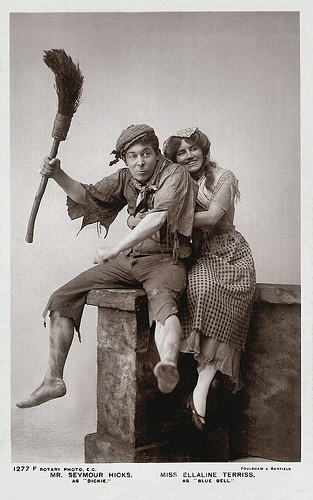
British postcard by Rotary, no. 1277 F. Photo: Foulsham & Bansfield. Publicity still for the play Bluebell in Fairyland (1901) with Ellaline Terriss.
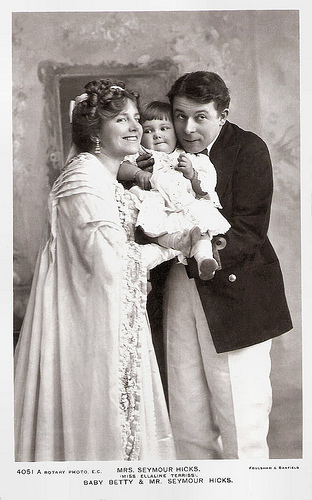
With Ellaline Terriss and Baby Betty. British postcard by Rotary, no. 4051 A. Photo: Foulsham & Bansfield.
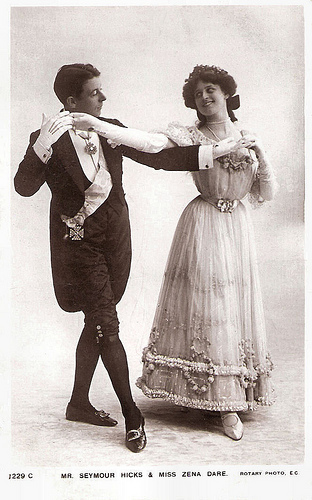
British postcard by Rotary, no. 1229 C F. With Zena Dare .
A Tour to France
After the outbreak of World War I, Seymour Hicks was the first British actor to bring a tour to France (with Terriss), giving concerts to British troops at the front. Because of this, he was awarded the French Croix de Guerre.
He continued to write light comedies, the most popular of which was The Happy Day (1916).
On film, he first appeared in the silent films Scrooge (Leedham Bantock, 1913), David Garrick (Leedham Bantock, 1913) and A Prehistoric Love Story (Leedham Bantock, 1915) with Isobel Elsom.
In 1923, he decided to produce his own films. His first film, in which he also starred, was Always Tell Your Wife (1923), which was based on one of his plays. While making that film, director Hugh Croise fell ill (or walked off the set or was fired; the sources differ) and Hicks hired an unknown young director to make his debut: Alfred Hitchcock.
Hicks directed Sleeping Partners (1930) and Glamour (1931). In addition, over a dozen films were made either from his plays or his scripts, and he starred in about twenty films, many with his wife.
In 1931, he was awarded the National Order of the Legion of Honour (Ordre national de la Légion d'honneur) for his promotion of French drama on the English stage.
In 1934, he had taken over Daly's Theatre in London, where he produced and appeared in a series of successful plays including Vintage Wine that he and Ashley Dukes adapted from a novel.
In 1935, he played his most famous stage role, Ebenezer Scrooge for a second time on film in Scrooge (Henry Edwards, 1935), produced in England The film has been praised for its vivid atmosphere, but most of the ghosts in the film are not seen onscreen, except for the Ghost of Christmas Present (Oscar Asche). Donald Calthrop portrays Bob Cratchit, and Maurice Evans has a bit part as one of Scrooge's debtors.
Later notable film roles included Sir John Tremayne in The Lambeth Walk (Albert de Courville, 1939) and Bunter in Busman's Honeymoon (Arthur B. Woods, Richard Thorpe, 1940).
Hicks published several autobiographies: Seymour Hicks: 24 Years of an Actor's Life (1910), Between Ourselves (1930), Me and My Missus (1939) etc.
Seymour Hicks continued to appear on stage and in films until a year before his death of influenza in 1949 in Hampshire, England, at the age of 78. He was the father of actress, Betty Hicks.
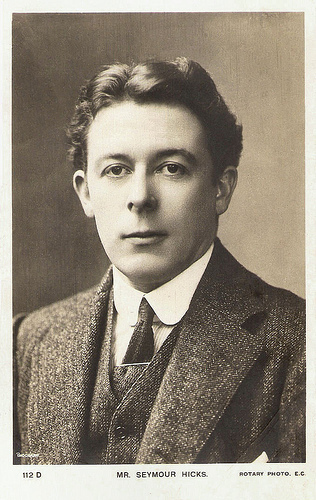
British postcard by Rotary Photo E.C., no. 112 D. Photo: Biograph.
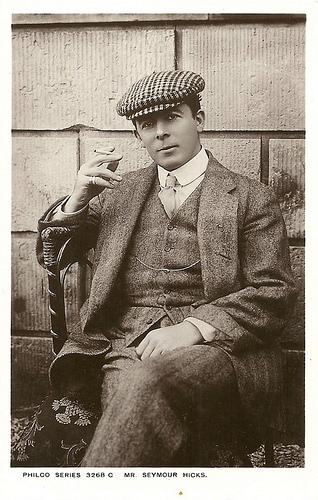
British postcard in the Philco Series, no. 3268 C.
Sources: Kurt Gänzl (The Encyclopaedia of the Musical Theatre), Wikipedia, and .

British postcard, no. 112.

British postcard in the Philco Series, no. 3201 F.
An Unaccustomed Light-hearted Air
Edward Seymour Hicks was born in St. Hélier on the Isle of Jersey, Great-Britain in 1871. He made his stage début at the age of nine. He appeared as Little Buttercup in Gilbert and Sullivan's H.M.S. Pinafore at his school in Bath. After that, he was determined to be an actor.
Hicks first appeared professionally on stage at the age of sixteen in a production of In the Ranks at the Grand, Islington. In 1889, he joined the theatrical company of Mr. and Mrs. Kendal for an American tour where they presented a repertory of contemporary plays.
Hicks starred as Dr. Watson in a parody of Sherlock Holmes, Under the Clock (1893) at the Royal Court Theatre. It was written by Hicks with Charles Brookfield, who played Holmes, and it was the first musical revue ever staged in London. That same year, he married Ellaline Terriss.
Then he starred in a revival of Little Jack Sheppard at the Gaiety Theatre, London which brought him to the attention of impresario George Edwardes. Edwardes cast Hicks in his next show, The Shop Girl (1894) opposite Ada Reeve . Kurt Gänzl in The Encyclopaedia of Musical Theatre : “The pair, comedy players both, gave an unaccustomed light-hearted air to the show's juvenile roles for, until that time, sentimentality rather than fun had been de rigueur in such parts, and Hicks scored a hit with the first of the many borrowed songs he would perform in shows over the years, Felix McGlennon's Her Golden Hair Was Hanging Down Her Back.
The emphasis on charming light comedy was increased when Hicks's wife, Ellaline Terriss, took over as 'the shop girl', and together this attractive, bright pair of young performers helped materially to seal the fate of the drooping/sighing, tenor/soprano lovers in London musical plays.” The Shop Girl played for 546 performances, and its success led to his participation in two more of Edwardes's hit ‘girl’ musicals, The Circus Girl (1896) and A Runaway Girl (1898), both starring Terriss.
In 1901, Hicks first played the role of Ebenezer Scrooge in Charles Dickens's A Christmas Carol and eventually played it thousands of times onstage. Hicks, along with his wife, joined the producer Charles Frohman in his theatre company and wrote and starred in a series of extraordinarily successful musicals, including Bluebell in Fairyland (1901), Quality Street (1902), The Earl and the Girl (1903) and The Catch of the Season (1904).
Hicks used his fortune from these shows to commission the building of the Aldwych Theatre in 1905 and the Hicks Theatre in 1906 (renamed as the Globe Theatre in 1909 and since 1994 known as the Gielgud Theatre). He opened the Hicks Theatre with a new hit show, The Beauty of Bath (1906).
Kurt Gänzl: “Hicks and Miss Terriss established themselves, during this period, not only as the town's favourite musical comedy hero and heroine, but also as the theatre's 'ideal couple'. As with most such couples, the ideal was a pretty fictional one, but Miss Terriss tactfully ignored Hicks's repeated trips to the ladies' chorus, and their charming public image lasted happily, to the great good of their popularity.”
Hicks’ stage performances were less successful in later years, and he opted instead to star in music hall tours, including Pebbles on the Beach (1912).

British postcard by Rotary, no. 1277 F. Photo: Foulsham & Bansfield. Publicity still for the play Bluebell in Fairyland (1901) with Ellaline Terriss.

With Ellaline Terriss and Baby Betty. British postcard by Rotary, no. 4051 A. Photo: Foulsham & Bansfield.

British postcard by Rotary, no. 1229 C F. With Zena Dare .
A Tour to France
After the outbreak of World War I, Seymour Hicks was the first British actor to bring a tour to France (with Terriss), giving concerts to British troops at the front. Because of this, he was awarded the French Croix de Guerre.
He continued to write light comedies, the most popular of which was The Happy Day (1916).
On film, he first appeared in the silent films Scrooge (Leedham Bantock, 1913), David Garrick (Leedham Bantock, 1913) and A Prehistoric Love Story (Leedham Bantock, 1915) with Isobel Elsom.
In 1923, he decided to produce his own films. His first film, in which he also starred, was Always Tell Your Wife (1923), which was based on one of his plays. While making that film, director Hugh Croise fell ill (or walked off the set or was fired; the sources differ) and Hicks hired an unknown young director to make his debut: Alfred Hitchcock.
Hicks directed Sleeping Partners (1930) and Glamour (1931). In addition, over a dozen films were made either from his plays or his scripts, and he starred in about twenty films, many with his wife.
In 1931, he was awarded the National Order of the Legion of Honour (Ordre national de la Légion d'honneur) for his promotion of French drama on the English stage.
In 1934, he had taken over Daly's Theatre in London, where he produced and appeared in a series of successful plays including Vintage Wine that he and Ashley Dukes adapted from a novel.
In 1935, he played his most famous stage role, Ebenezer Scrooge for a second time on film in Scrooge (Henry Edwards, 1935), produced in England The film has been praised for its vivid atmosphere, but most of the ghosts in the film are not seen onscreen, except for the Ghost of Christmas Present (Oscar Asche). Donald Calthrop portrays Bob Cratchit, and Maurice Evans has a bit part as one of Scrooge's debtors.
Later notable film roles included Sir John Tremayne in The Lambeth Walk (Albert de Courville, 1939) and Bunter in Busman's Honeymoon (Arthur B. Woods, Richard Thorpe, 1940).
Hicks published several autobiographies: Seymour Hicks: 24 Years of an Actor's Life (1910), Between Ourselves (1930), Me and My Missus (1939) etc.
Seymour Hicks continued to appear on stage and in films until a year before his death of influenza in 1949 in Hampshire, England, at the age of 78. He was the father of actress, Betty Hicks.

British postcard by Rotary Photo E.C., no. 112 D. Photo: Biograph.

British postcard in the Philco Series, no. 3268 C.
Sources: Kurt Gänzl (The Encyclopaedia of the Musical Theatre), Wikipedia, and .
Published on June 17, 2014 23:00
June 16, 2014
Karl Ludwig Diehl
German film actor Karl Ludwig Diehl (1896-1958) appeared in 66 films between 1924 and 1957. Although he is forgotten now, he was one of the of the most prominent German film actors of the 1930s and 1940s.
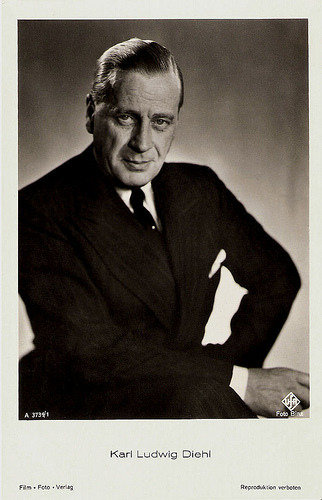
German postcard by Film-Foto-Verlag, no. A 3739/1, 1941-1944. Photo: Ufa / Binz.
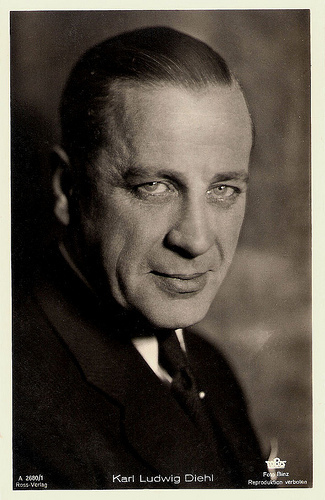
German postcard by Ross-Verlag, no. A 2680/1, 1939-1940. Photo: Tobis / Binz.
Gentleman-detective
Karl Ludwig Diehl was born in Halle an der Saale, Germany in 1896 as the son of economist Carl Diehl.
He visited a humanistic Gymnasium in Königsberg and in Freiburg. After graduation, he took acting lessons, but after the start of the First World War he was recruited as a soldier.
In 1919 he was able to continue his training at the Drama School of the Deutsches Theater in Berlin and received first engagements in Wiesbaden, at the prestigious Münchner Kammerspiele in Munich and at the Schillertheater in Berlin.
In 1924, he made his film debut with a supporting role in Die Tragödie der Entehrten/The Tragedy of the Dishonoured (Josef Berger, 1924), a production of the Union Film Co. Ltd. in Munich. In the same year he also appeared in his second film, Die Schuld/The Blame (Josef Berger, 1924).
Five years later he went to Berlin. There he played his first starring role in the silent crime film Masken/Masks (Rudolf Meinert, 1929), a remake of a successful film from 1919. Diehl played the hero, gentleman-detective Stuart Webb and his co-stars were Trude Berliner and Italian star Marcella Albani .
That same year, he starred as Lord Chamberlain opposite Lilian Harvey and Willy Fritsch in both the German and the English versions of the Ufa operetta film Liebeswalzer/Waltz of Love (Wilhelm Thiele, 1929), his first sound film.
He appeared in the hit Der Greife/The Snatcher (Richard Eichberg, 1930) starring Hans Albers . The film was shot concurrently in a German and an English language version (Night Birds). This was a fairly common practice in the early days of talking pictures, when it was not yet practical to overdub dialogue soundtracks.
He co-starred with Lissi Arna in Der Zinker/The Squeaker (Martin Frič, Karel Lamač, 1931), based on an Edgar Wallace novel and also shot in a Czech version.

German postcard by Ross-Verlag, no. A 3344/1, 1941-1944. Photo: Tobis / Binz.
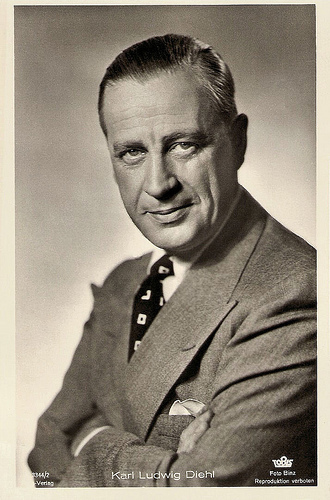
German postcard by Film-Foto-Verlag, no. A 3344/2, 1941-1944. Photo: Tobis / Binz.
Unusually serious social comment
Karl Ludwig Diehl continued to work for Ufa and other smaller production companies in Berlin. With his distinguished appearance he often played diplomats, noblemen, officers, attorneys, bankers, engineers or doctors.
He was a count in the historical drama Rasputin, Dämon der Frauen/Rasputin, Demon with Women (Adolf Trotz, 1932) starring Conrad Veidt as Gregory Rasputin who wielded influence over the Russian Royal Family around the time of the First World War.
In 1933, Diehl starred in the British thriller On Secret Service (Arthur B. Woods, 1933) with Greta Nissen . The following year, he starred in the Ufa production Ein Mann will nach Deutschland/A man wants to Germany (Paul Wegener, 1934), one of the first films that were totally paid for by the Nazi regime. He portrayed a patriotic German engineer who operates in South America when the First World War starts. He flouts many resistances and the attraction of a rich local ( Brigitte Horney ) to return home, so he can register as a war volunteer there.
However, the following year Diehl starred in the Austrian romantic comedy Episode (1935), directed, written and produced by Walter Reisch. It is remarkable because it is the only Austrian film with a Jewish producer that was permitted to be imported and shown in Nazi Germany after 1933 and the ban on Jews working in the film industry. The credits were spoken against a musical background; when Reisch's name was reached, the music in German cinemas swelled to make it inaudible. Episode belongs to the popular Austrian light romantic comedy genre known as the Wiener Film, but also contains, for a film of this genre, unusually serious social comment.
From 1931 on, Diehl appeared again and again as a film lover, although he radiated more integrity and reliability than sensuality.
His romantic films include Zwei in einem Auto/Two in a car (Joe May, 1931) with Magda Schneider , Die Freundin eines großen Mannes/The girlfriend of a great man ( Paul Wegener , 1934), with Käthe von Nagy , Liebe geht seltsame Wege/Love goes strange ways (Hans H. Zerlett, 1937), with Olga Tschechova , Die schwedische Nachtigall/The Swedish Nightingale (Peter Paul Btauer, 1941), with Ilse Werner , Nacht ohne Abschied/Night without saying goodbye (Erich Waschneck, 1941-1943) opposite Anna Dammann and Die Hochstaplerin/The imposter (Karl Anton, 1943), with Sybille Schmitz .
Herbert Selpin’s faithful Oscar Wilde adaptation Ein idealer Gatte/An Ideal Husband (1935) was the first in a series of films in which Diehl played husbands who make up for their lack of lover qualities with loyalty and reliability.
Other examples are Es geht um mein Leben/It's My Life (Richard Eichberg, 1936) with Kitty Jantzen, the Effi Briest adaptation Der Schritt vom Wege/The step of the way (Gustaf Gründgens, 1939) and Annelie (Josef von Baky, 1941) with Luise Ullrich .
Likewise, Diehl embodied exemplary fathers in the films Seine Tochter ist der Peter/His daughter is Peter (Heinz Helbig, 1936) with child actress Traudl Stark , and Der grüne Domino/The Green Domino (Herbert Selpin, 1935) with Brigitte Horney .
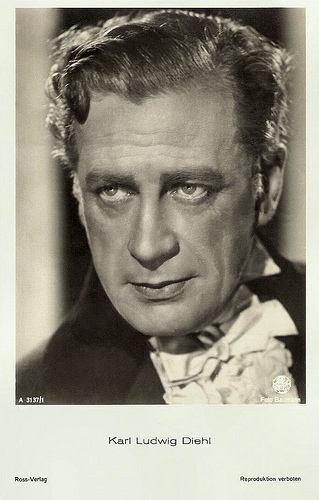
German postcard by Ross-Verlag, no. A 3137/1, 1941-1944. Photo: Terra / Baumann.
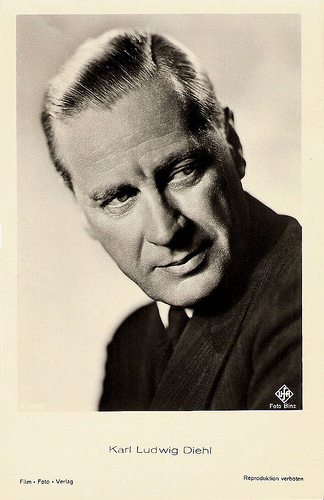
German postcard by Film-Foto-Verlag, no. A 3466/1, 1941-1944. Photo: Ufa / Binz.
State Actor of the Third Reich
In 1939, Karl Ludwig Diehl was appointed state actor by the Minister of Public Enlightenment and Propaganda, Joseph Goebbels and subsequently worked in another propaganda film.
He played an Irish baron in the anti-British drama Der Fuchs von Glenarvon/The fox of Glenarvon (Max W. Kimmich, 1940) with Olga Tschechova and Ferdinand Marian . It portrayed the years of the Irish fight for independence during World War I and stands in a long line of anti-British propaganda films that portray the British as oppressors or traitors of minorities.
He also starred in the German sports film Das große Spiel/The Big Game (Robert A. Stemmle, 1942). It featured famous German footballers of the era. National coach Sepp Herberger arranged for many German international footballers to be recalled from fighting in the Second World War, ostensibly to improve the quality of the film, but actually to try to protect them from the horrors of war.
Also remarkable was the German war film Der 5. Juni/5 June (Fritz Kirchhoff, 1942) starring Carl Raddatz . The film depicts the events of 1940 when German forces successfully invaded France. It was shot on location in France and Germany. Constant changes to the film, often at the request of the German military, led to large cost overruns. In November 1942 the film was banned by Joseph Goebbels for unspecified reasons. It has been speculated that Goebbels thought the film was not entertaining enough or wished to avoid offending the Vichy government of France.
After WWII, Diehl had theatre engagements in Konstanz, Göttingen and Munich.
In the 1950s, he returned to the cinema. In Germany he played small parts in films like Mädchenjahre einer Königin/The Story of Vickie (Ernst Marischka, 1954) as prime minister Lord Melbourne opposite Romy Schneider as the young Queen Victoria, Des Teufels General/The Devil's General (Helmut Käutner, 1955) starring Curd Jürgens , and Es geschah am 20. Juli/It Happened on July 20th (Georg Wilhelm Pabst, 1955), a dramatic reconstruction of the July 1944 attempt by German Army Officers to assassinate Adolf Hitler with a bomb and to end the war before Germany was totally destroyed.
In Italy he acted in the drama Atto d'accusa/The Accusation (Giacomo Gentilomo, 1951) with Marcello Mastroianni . Diehl starred in 16 more films, but was unable to match his earlier success.
Since 1930, he was married to with Mary von Ruffin, the sister of actor Kurt von Ruffin. They had two daughters. Karl Ludwig Diehl died in his villa Berghof near Penzberg in Bavaria in 1958. He was 61.
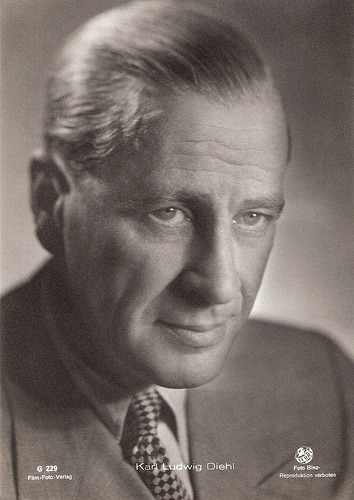
German postcard by Film-Foto-Verlag, no. G 229, 1941-1944. Photo: Terra / Binz.
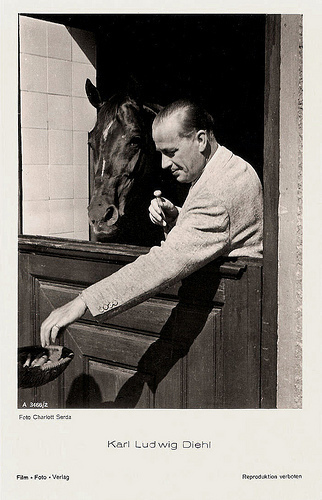
German postcard by Film-Foto-Verlag, no. A 3466/2, 1941-1944. Photo: Charlott Serda.
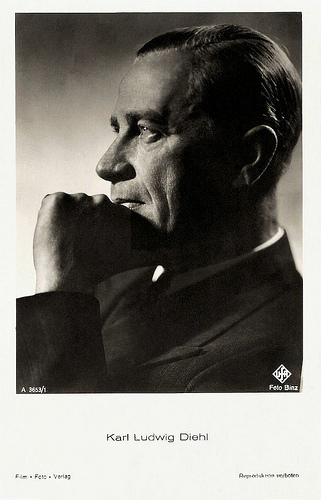
German postcard by Film-Foto-Verlag, no. A 3653/1, 1941-1944. Photo: Ufa / Binz.
Sources: Stephanie D’heil (Steffi-Line), Thomas Staedeli (Cyranos), Filmportal.de (German), Wikipedia (German and English) and .

German postcard by Film-Foto-Verlag, no. A 3739/1, 1941-1944. Photo: Ufa / Binz.

German postcard by Ross-Verlag, no. A 2680/1, 1939-1940. Photo: Tobis / Binz.
Gentleman-detective
Karl Ludwig Diehl was born in Halle an der Saale, Germany in 1896 as the son of economist Carl Diehl.
He visited a humanistic Gymnasium in Königsberg and in Freiburg. After graduation, he took acting lessons, but after the start of the First World War he was recruited as a soldier.
In 1919 he was able to continue his training at the Drama School of the Deutsches Theater in Berlin and received first engagements in Wiesbaden, at the prestigious Münchner Kammerspiele in Munich and at the Schillertheater in Berlin.
In 1924, he made his film debut with a supporting role in Die Tragödie der Entehrten/The Tragedy of the Dishonoured (Josef Berger, 1924), a production of the Union Film Co. Ltd. in Munich. In the same year he also appeared in his second film, Die Schuld/The Blame (Josef Berger, 1924).
Five years later he went to Berlin. There he played his first starring role in the silent crime film Masken/Masks (Rudolf Meinert, 1929), a remake of a successful film from 1919. Diehl played the hero, gentleman-detective Stuart Webb and his co-stars were Trude Berliner and Italian star Marcella Albani .
That same year, he starred as Lord Chamberlain opposite Lilian Harvey and Willy Fritsch in both the German and the English versions of the Ufa operetta film Liebeswalzer/Waltz of Love (Wilhelm Thiele, 1929), his first sound film.
He appeared in the hit Der Greife/The Snatcher (Richard Eichberg, 1930) starring Hans Albers . The film was shot concurrently in a German and an English language version (Night Birds). This was a fairly common practice in the early days of talking pictures, when it was not yet practical to overdub dialogue soundtracks.
He co-starred with Lissi Arna in Der Zinker/The Squeaker (Martin Frič, Karel Lamač, 1931), based on an Edgar Wallace novel and also shot in a Czech version.

German postcard by Ross-Verlag, no. A 3344/1, 1941-1944. Photo: Tobis / Binz.

German postcard by Film-Foto-Verlag, no. A 3344/2, 1941-1944. Photo: Tobis / Binz.
Unusually serious social comment
Karl Ludwig Diehl continued to work for Ufa and other smaller production companies in Berlin. With his distinguished appearance he often played diplomats, noblemen, officers, attorneys, bankers, engineers or doctors.
He was a count in the historical drama Rasputin, Dämon der Frauen/Rasputin, Demon with Women (Adolf Trotz, 1932) starring Conrad Veidt as Gregory Rasputin who wielded influence over the Russian Royal Family around the time of the First World War.
In 1933, Diehl starred in the British thriller On Secret Service (Arthur B. Woods, 1933) with Greta Nissen . The following year, he starred in the Ufa production Ein Mann will nach Deutschland/A man wants to Germany (Paul Wegener, 1934), one of the first films that were totally paid for by the Nazi regime. He portrayed a patriotic German engineer who operates in South America when the First World War starts. He flouts many resistances and the attraction of a rich local ( Brigitte Horney ) to return home, so he can register as a war volunteer there.
However, the following year Diehl starred in the Austrian romantic comedy Episode (1935), directed, written and produced by Walter Reisch. It is remarkable because it is the only Austrian film with a Jewish producer that was permitted to be imported and shown in Nazi Germany after 1933 and the ban on Jews working in the film industry. The credits were spoken against a musical background; when Reisch's name was reached, the music in German cinemas swelled to make it inaudible. Episode belongs to the popular Austrian light romantic comedy genre known as the Wiener Film, but also contains, for a film of this genre, unusually serious social comment.
From 1931 on, Diehl appeared again and again as a film lover, although he radiated more integrity and reliability than sensuality.
His romantic films include Zwei in einem Auto/Two in a car (Joe May, 1931) with Magda Schneider , Die Freundin eines großen Mannes/The girlfriend of a great man ( Paul Wegener , 1934), with Käthe von Nagy , Liebe geht seltsame Wege/Love goes strange ways (Hans H. Zerlett, 1937), with Olga Tschechova , Die schwedische Nachtigall/The Swedish Nightingale (Peter Paul Btauer, 1941), with Ilse Werner , Nacht ohne Abschied/Night without saying goodbye (Erich Waschneck, 1941-1943) opposite Anna Dammann and Die Hochstaplerin/The imposter (Karl Anton, 1943), with Sybille Schmitz .
Herbert Selpin’s faithful Oscar Wilde adaptation Ein idealer Gatte/An Ideal Husband (1935) was the first in a series of films in which Diehl played husbands who make up for their lack of lover qualities with loyalty and reliability.
Other examples are Es geht um mein Leben/It's My Life (Richard Eichberg, 1936) with Kitty Jantzen, the Effi Briest adaptation Der Schritt vom Wege/The step of the way (Gustaf Gründgens, 1939) and Annelie (Josef von Baky, 1941) with Luise Ullrich .
Likewise, Diehl embodied exemplary fathers in the films Seine Tochter ist der Peter/His daughter is Peter (Heinz Helbig, 1936) with child actress Traudl Stark , and Der grüne Domino/The Green Domino (Herbert Selpin, 1935) with Brigitte Horney .

German postcard by Ross-Verlag, no. A 3137/1, 1941-1944. Photo: Terra / Baumann.

German postcard by Film-Foto-Verlag, no. A 3466/1, 1941-1944. Photo: Ufa / Binz.
State Actor of the Third Reich
In 1939, Karl Ludwig Diehl was appointed state actor by the Minister of Public Enlightenment and Propaganda, Joseph Goebbels and subsequently worked in another propaganda film.
He played an Irish baron in the anti-British drama Der Fuchs von Glenarvon/The fox of Glenarvon (Max W. Kimmich, 1940) with Olga Tschechova and Ferdinand Marian . It portrayed the years of the Irish fight for independence during World War I and stands in a long line of anti-British propaganda films that portray the British as oppressors or traitors of minorities.
He also starred in the German sports film Das große Spiel/The Big Game (Robert A. Stemmle, 1942). It featured famous German footballers of the era. National coach Sepp Herberger arranged for many German international footballers to be recalled from fighting in the Second World War, ostensibly to improve the quality of the film, but actually to try to protect them from the horrors of war.
Also remarkable was the German war film Der 5. Juni/5 June (Fritz Kirchhoff, 1942) starring Carl Raddatz . The film depicts the events of 1940 when German forces successfully invaded France. It was shot on location in France and Germany. Constant changes to the film, often at the request of the German military, led to large cost overruns. In November 1942 the film was banned by Joseph Goebbels for unspecified reasons. It has been speculated that Goebbels thought the film was not entertaining enough or wished to avoid offending the Vichy government of France.
After WWII, Diehl had theatre engagements in Konstanz, Göttingen and Munich.
In the 1950s, he returned to the cinema. In Germany he played small parts in films like Mädchenjahre einer Königin/The Story of Vickie (Ernst Marischka, 1954) as prime minister Lord Melbourne opposite Romy Schneider as the young Queen Victoria, Des Teufels General/The Devil's General (Helmut Käutner, 1955) starring Curd Jürgens , and Es geschah am 20. Juli/It Happened on July 20th (Georg Wilhelm Pabst, 1955), a dramatic reconstruction of the July 1944 attempt by German Army Officers to assassinate Adolf Hitler with a bomb and to end the war before Germany was totally destroyed.
In Italy he acted in the drama Atto d'accusa/The Accusation (Giacomo Gentilomo, 1951) with Marcello Mastroianni . Diehl starred in 16 more films, but was unable to match his earlier success.
Since 1930, he was married to with Mary von Ruffin, the sister of actor Kurt von Ruffin. They had two daughters. Karl Ludwig Diehl died in his villa Berghof near Penzberg in Bavaria in 1958. He was 61.

German postcard by Film-Foto-Verlag, no. G 229, 1941-1944. Photo: Terra / Binz.

German postcard by Film-Foto-Verlag, no. A 3466/2, 1941-1944. Photo: Charlott Serda.

German postcard by Film-Foto-Verlag, no. A 3653/1, 1941-1944. Photo: Ufa / Binz.
Sources: Stephanie D’heil (Steffi-Line), Thomas Staedeli (Cyranos), Filmportal.de (German), Wikipedia (German and English) and .
Published on June 16, 2014 23:00
Paul van Yperen's Blog
- Paul van Yperen's profile
- 13 followers
Paul van Yperen isn't a Goodreads Author
(yet),
but they
do have a blog,
so here are some recent posts imported from
their feed.



